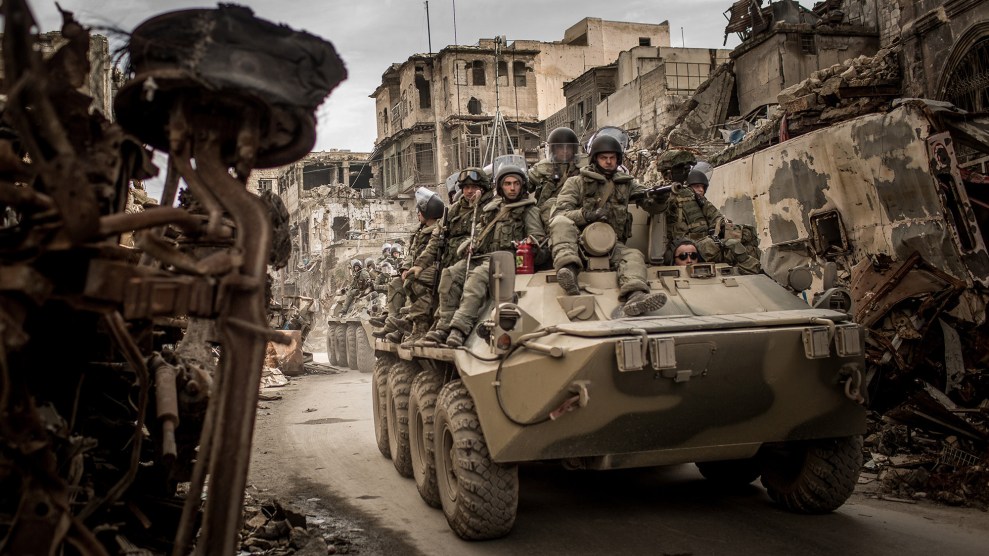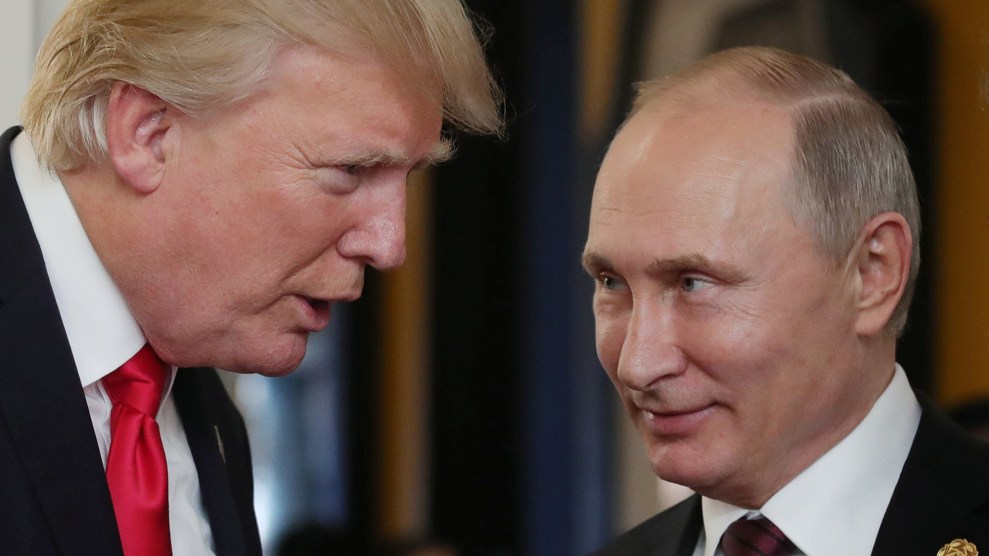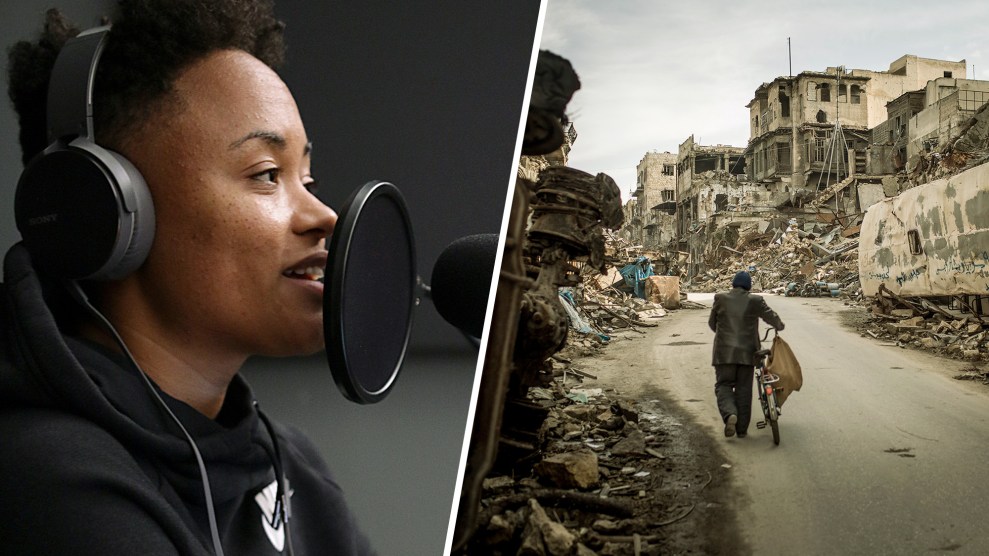I disembark with a handful of locals and walk up a gravelly slope to a small shack. Iraq, which I just came from, is on the opposite side of the river. Turkey is not far upstream. A man with a wrinkled, sun-worn face and an AK-47 asks for our passports.
I don’t have a visa. One month after I submitted my application for one, the Syrian government dropped a chemical bomb on a building in Ghouta, outside Damascus. The United Nations said it killed 49 civilians, including 11 children. As I was waiting for a decision, President Donald Trump tweeted that Syrian President Bashar al-Assad—“Animal Assad”—would pay a “big price” for the attack. Less than a week later, the United States, the United Kingdom, and France bombed several research and military buildings. The Syrian Embassy in Beirut emailed me shortly afterward: “We want to inform you that your visa request has been rejected due to the lack of objectivity in the reports approaching the Syrian crisis.”
[Read the five key takeaways from this article, listen to this article read aloud, and check out our three-part podcast based on Shane’s reporting.]
But this border crossing isn’t controlled by the Assad government. It’s controlled by the Syrian Democratic Forces, an alliance of militias backed by the United States and the Global Coalition to Defeat ISIS. The SDF currently controls about 25 percent of Syria, an area known as the Democratic Federation of Northern Syria. The area encompasses largely Arab regions as well as most of the predominantly Kurdish region Rojava. Most of the roughly 2,000 US special operations troops in Syria are based in the region, spread across about a dozen bases.
As the Kurdish border guard with the AK flips through my passport, his face brightens. “Are you American?” he asks. “You are holy to us! The Kurdish people love Americans!” He lights a cigarette and takes a drag. “If it was up to us, we wouldn’t let the Americans leave,” he says. “They would stay here forever.” He tells me Turkish troops occasionally fire mortars at their position, small reminders of what awaits if US forces withdraw.
“Will they leave us?” another man asks me. He is Arab.
“It’s not clear,” I say. Five weeks earlier, Trump had announced he was pulling all US troops out of Syria “very soon,” but he’d walked back his statement a few days later. It wouldn’t be the last time he would do so.
“Maybe they will leave,” the Arab man says.
“No!” exclaims the wrinkled border guard.
“We have oil, so much oil,” the Arab says. “Let them stay and take the oil.”
“If American and Western companies—not Russian companies!—came and explored the region, they’d find more oil than Iraq,” the Kurd says. “There is oil, there is gas, there is phosphorus, whatever you want!” A chorus of birds rises with the waning heat. “We do whatever the coalition tells us to do. Directly! If it wasn’t for the coalition, we wouldn’t be here.” Assad, Turkey, what’s left of the Islamic State, and many of the rebel groups that were armed and trained by the CIA want to see the end of this territory. “If someone defends you, aren’t you going to give your life and your children’s lives to him? That’s the law of the universe, my brother.”
It’s been nine years since I was last in Syria. I’d spent a year and a half here, first studying Arabic in Damascus, then using the country as a home base while I was starting out as a reporter. I remember how, back in 2009, my Syrian friends would fantasize about being rid of the dictator and his secret police, but no one could have imagined that the Arab Spring would come two years later. It spread to Syria, but Assad did not leave. The revolt against the regime turned into a civil war, and nearly everyone I knew fled the country. Some ended up in Europe and South America, others in Lebanon and Turkey. I went back to the Middle East once in 2014 to see friends who’d become refugees. I wrote about what had happened to their neighborhood, where the regime was starving people to death.
After that, I lost touch. The news coming from Syria became darker. Cities were being leveled by Syrian bombs, then by Russian planes. The regime was poisoning children with chemical attacks. ISIS was chopping off heads and isolating large chunks of the country from the outside world. Photographs were smuggled out showing the bodies of thousands of people who had been tortured to death in Assad’s prisons. More and more, Syria was looking like the kind of tragedy the world had promised would never happen again, and no one knew what to do about it. As of today, some 12 million Syrians have fled their homes, more than half the country’s prewar population. About 1 in 10 Syrians have been injured or killed. The exact number of dead is a mystery—the United Nations stopped counting in 2014—but a 2016 report by an independent organization put it at around 500,000.
Like many Americans, I was overwhelmed and disheartened by the scope of the tragedy. It didn’t help that the war in Syria was complicated to the point of absurdity. What had started as a homegrown effort to oust a regime that has held the country in its iron fist since 1970 became a magnet for many outside interests. The United States is only one player in a battlefield that has included hundreds of armed Syrian factions; Russian, Iranian, Turkish, British, and French troops; Al Qaeda and the Islamic State; Hezbollah and Iraqi militias; Russian and Afghan mercenaries; and Saudi and Qatari funders and arms suppliers. On top of all this, a concerted Syrian and Russian disinformation campaign has blurred the facts of the regime’s atrocities.
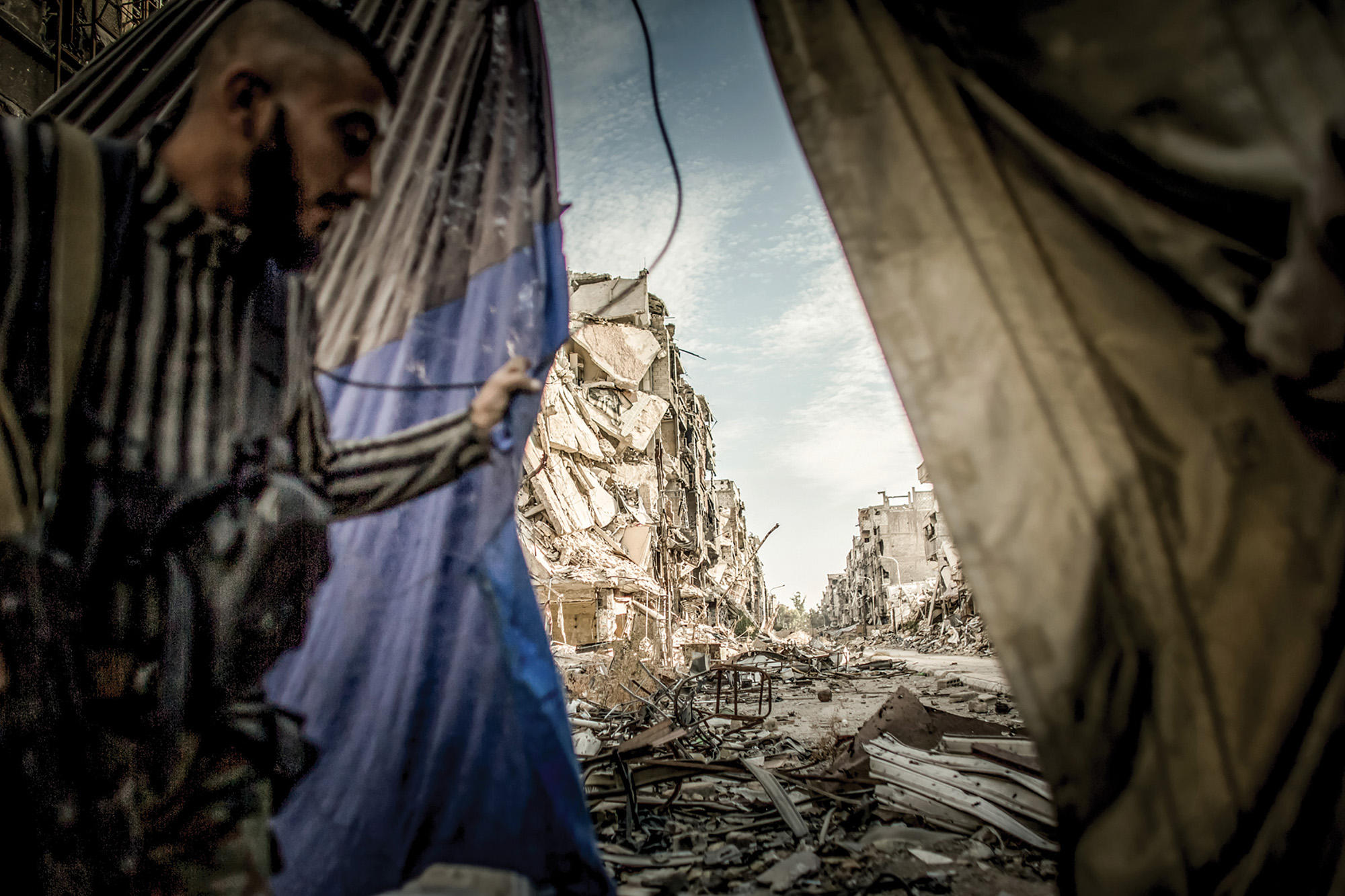
The Syrian war has become such a fog that few Americans know the extent to which we have been involved. Even those who are paying attention struggled to form a clear opinion. The United States did not start the war in Syria, but the only thing that seemed worse than getting sucked into the conflict was not getting involved at all. Could we stand aside as the Syrian government slaughtered its people? What about ISIS? What about our obligation to take in some of the millions of refugees? At the same time, should we be fighting a shadow war against Russia and Iran? Americans’ conflicted feelings about getting involved led to inconsistent reactions to our government’s fitful attempts to influence the war’s outcome. Most Americans said they supported Trump’s 2017 bombing of a Syrian air base in retaliation for Assad’s use of chemical weapons on civilians. Yet there was next to no outcry as the US-led coalition against ISIS nearly flattened the city of Raqqa, inflicting heavy civilian casualties, later that year.
American involvement in Syria has been as fragmented and volatile as the conflict itself. Official policy has gone from demanding that Assad step down to allowing him to stay in power as the opposition has grown weaker and groups hostile to the United States have flourished. The Obama and Trump administrations have backed opposing armed factions. The CIA has spent more than $1 billion in Syria, one of its costliest covert operations since it backed the mujahideen against the former Soviet Union in Afghanistan. Operation Inherent Resolve, the Pentagon’s campaign against ISIS, has launched more than 19,280 airstrikes and cost $54 billion in Syria alone. Our SDF allies now control a large portion of the country’s oil and natural gas reserves, much of it seized with help from coalition planes. Meanwhile, the United States and Russia have fought a proxy war against each other while simultaneously aligning themselves against the common enemy of ISIS.
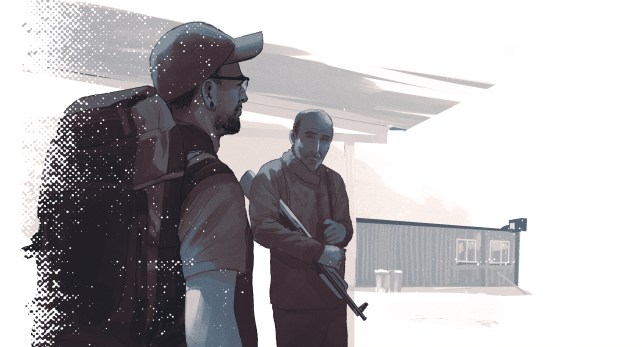
“If it was up to us, we wouldn’t let the Americans leave,” says the border guard.
Owen Freeman
I came here to try to untangle our role in what has been one of the greatest tragedies of the 21st century. My ride picks me up from the border and we drive into the green plains. Oil derricks slowly bob up and down along the road. A young man kicks a ball on a soccer pitch not far from a coalition air base. Many details are immediately familiar: the men in little towns collecting empty tea glasses from café patrons, and the smell of car exhaust, hookah smoke, spices, and cement.
The roads and towns are guarded by the SDF and its police forces, but in the center of Qamishli, the de facto Kurdish capital, our car enters a roundabout flanked by Syrian government troops and billboards, some depicting Assad in aviator shades and some showing the faces of his soldiers killed in battle. At the middle of the traffic circle stands a tall white statue of the president’s father, Hafez al-Assad, the kind of monument that was torn down by protesters when the revolt against Bashar started. The regime still controls several surrounding city blocks, where it maintains a courthouse and administrative offices. My driver tells me US special forces frequently drive through this roundabout, unmolested by the Syrians. They understand as well as anybody that in Syria, different Americans are fighting different wars. Sometimes it is better to pretend you don’t notice them.
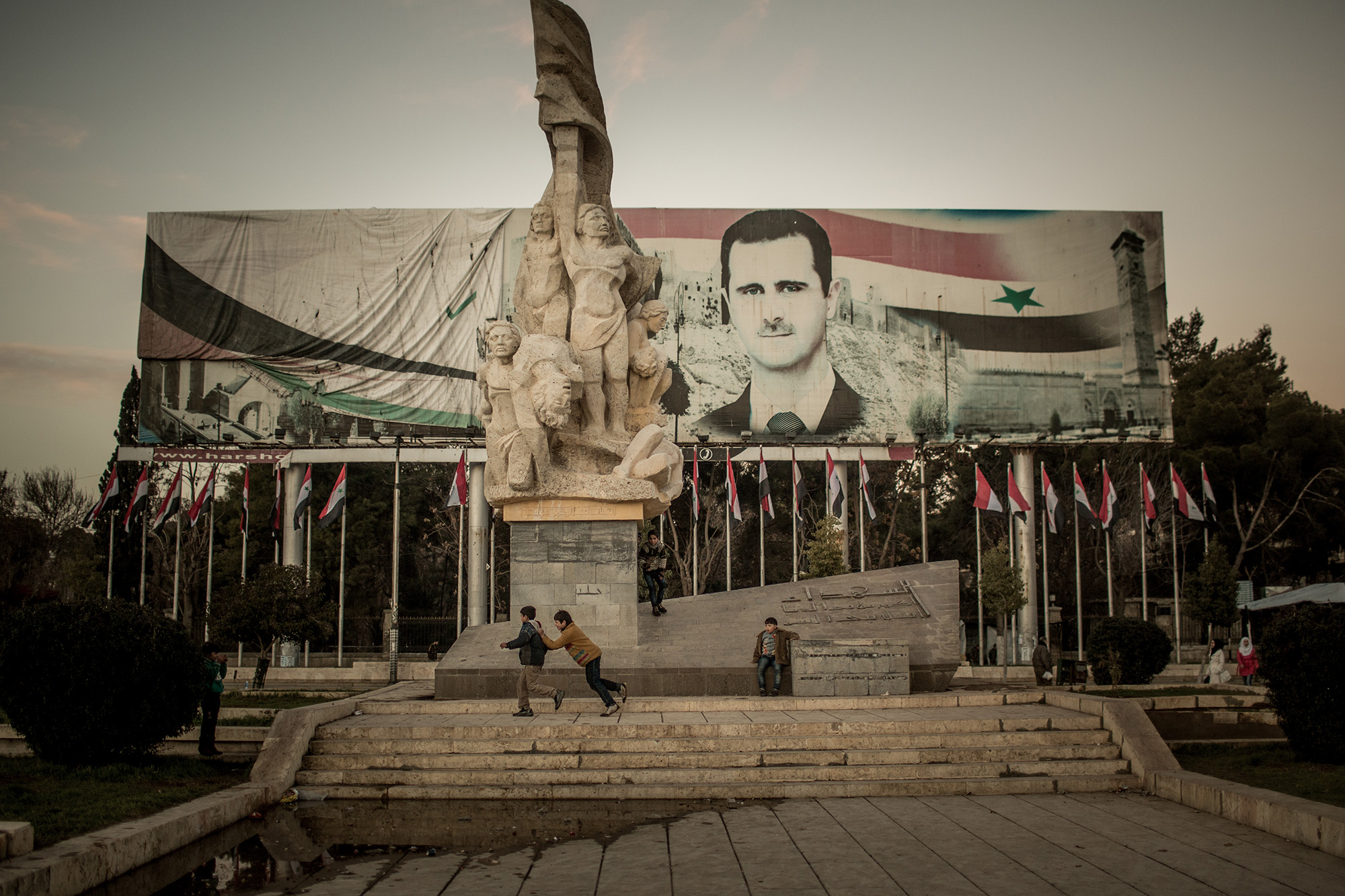
In early March that year, police in the southern city of Daraa ripped out the fingernails of teenagers who had been arrested for spray-painting anti-regime slogans. When the teens’ families rallied to call for their release, security forces fired on the crowd, killing six. In the following days, protesters expanded their demands on the government: release political prisoners, end corruption, and repeal the country’s nearly 50-year-old emergency law. Rioters set fire to local headquarters of the Baath Party and Syriatel, a company owned by the president’s cousin, believed to be the richest man in Syria.
Bashar al-Assad tried to stop the mayhem by ordering that the teens be released, but it was too late. By the end of the month, protesters in Daraa had torn down a statue of Hafez al-Assad, and security forces had attacked a mosque where demonstrators had taken refuge. People across the country were now calling for the president to resign.
During the first two weeks of the uprising, Assad did not appear in public. Then, in late March, his vice president said Assad would announce some decisions that would “please the people.” When the president entered parliament on March 30, members rose and chanted, “Our soul, our blood, we sacrifice for you, Bashar!” He stood before them bashfully, the picture of the well-intentioned ruler many Syrians still believed him to be.
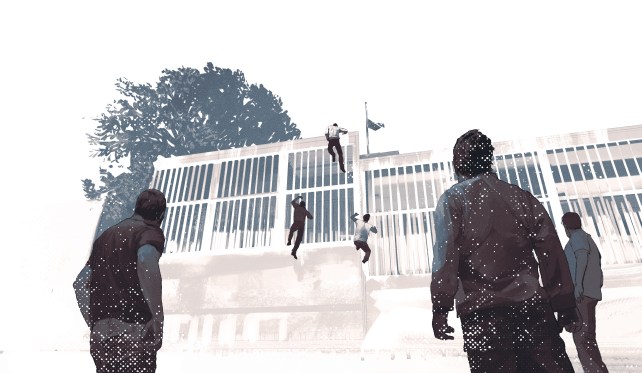
Intruders scaled the embassy fence “like they were trained commandos.”
Owen Freeman
The Assads had been credited with maintaining their country’s stability. In the two decades before they took power, there had been a series of military coups; the CIA had made several efforts to install pro-American, anti-Soviet leaders during the late 1940s and 1950s. Syria became a Soviet client state following Hafez al-Assad’s takeover in 1970, establishing its ongoing relationship with Russia. Hafez guarded himself against challengers by installing members of his minority Alawite sect in high-level positions in the government, the military, and the vast security state. His party implemented quasi-socialist welfare policies, but after the fall of the Soviet Union, he started to liberalize the economy.
After taking office in 2000, Bashar al-Assad ended his father’s ban on satellite TV and lifted restrictions on the internet. These were taken as signs that the country was opening up. Syrians were hopeful. During what came to be known as the Damascus Spring, about 1,000 intellectuals and activists signed a statement calling for political reforms. The regime responded with arrests and threats by the secret police.
Still, many Syrians believed Assad wanted change but was held back by the regime’s old guard. His appearance on March 30, 2011, was a chance to admit his government’s faults, grant real concessions, and announce elections, which he likely would have won. His 45-minute speech, however, focused not on the grievances raised in the streets, but on the “great conspiracy” aiming to tear his country apart. He blamed the unrest on Syria’s enemies, who “work every day in an organized, systematic, and scientific manner.” These foes, he said, had spread false information and fake images made to look like the Arab Spring uprisings. His claims would be echoed by a pro-regime television station that falsely reported the Qatar-based Al Jazeera had created replicas of Syrian cities where American and French directors were planning to film phony protests. It was a preview of the fake news campaign, amplified by Russian state TV and social-media accounts, that would deflect scrutiny of the regime’s crimes by spinning conspiracy theories. “Burying sedition is a national, moral, and religious duty,” Assad said at the close of his speech. “All those who can contribute to burying it and do not are part of it…There is no compromise or middle way in this.”
Blaming internal issues on nefarious outside forces was an old regime tactic. It didn’t help that the United States had tried to destabilize Assad before the revolt. A classified State Department cable published by WikiLeaks showed that after the Bush administration cut ties with Syria in 2005 for its alleged role in the assassination of former Lebanese Prime Minister Rafik Hariri, Ambassador William Roebuck proposed setting up political provocations by Syrian defectors that could cause a “self-defeating over-reaction” by the regime. Other cables showed that the United States had funneled millions of dollars to a London-based network of exiles and Muslim Brotherhood members who wanted to see Assad removed. Within Syria, opposition groups had been skeptical of American support. When the Bush administration announced it was offering $5 million to help the Syrian opposition, another cable noted that Syrian activists scolded their American contacts for attempting to treat them like a “chip in the game” against Assad, warning that the regime “will use it in the coming months to further discredit its opponents as agents of the Americans.”
While some Syrians may have been persuaded by Assad’s claim that foreign agitators had staged the uprising, many were outraged by his denial of responsibility. Following his speech, thousands turned out for Friday protests across the country, and at least 10 people were killed. A few weeks later, government troops and tanks entered Daraa, cutting off phone service, electricity, and water, and stationing snipers on top of mosques. Soldiers and armed thugs known as shabiha went house to house, searching for protesters. The body of a 13-year-old boy who had been arrested at a rally in a nearby village was returned to his family a month later covered with bruises, burns, gashes, and bullet wounds. His neck was broken and his penis had been cut off.
At the end of April, after hundreds of Syrians had been killed, the United States took its first concrete action against the regime. President Barack Obama issued an executive order placing sanctions on Syria’s intelligence agency and Iran’s Islamic Revolutionary Guard Corps, which the United States accused of assisting Assad’s crackdown. Three weeks later, Assad was added to the list. No one in Washington realized how impervious he would be to outside pressure or the disintegration of his international image. US Ambassador Robert Ford would soon find out.
In July 2011, Ford decided to observe the Friday protest planned in Hama, a city north of Damascus. He’d heard that the Syrian army was amassing troops around the city. It was an ominous sign. If the Syrian military went into Hama, he thought “there would almost certainly be large-scale violence.” It was there, after all, that Assad’s father had ordered the massacre of thousands of civilians nearly 30 years earlier. Ford wanted to send a message to the Syrian government: “We’re watching, and we will speak out. This will not be a repeat of 1982, when nobody knew what you did and nobody said anything.”
There were already hints that the turmoil could explode into war. A month earlier, government snipers had fired on demonstrators in a town near the Turkish border, setting off violent clashes. After the chaos, a video appeared on YouTube of a soldier named Lt. Colonel Hussein Harmoush. In what would become an iconic gesture for defecting soldiers, he held up his identity card and read a statement announcing he was leaving the army because of its violence against unarmed civilians. Soldiers like Harmoush were defecting in increasing numbers, forming militias to protect their communities from government attacks. Harmoush and his fellow former officers would soon join other rebels under the umbrella of the newly formed Free Syrian Army. The uprising, he said, was pro-democracy and anti-sectarian: “Syria will outlast Bashar. Bashar will go.”
Ford informed the Syrian Foreign Ministry of his trip to Hama, and on July 7 he made the three-hour drive from Damascus with his defense attaché and two security officers. When they arrived, young men with their faces wrapped in kaffiyehs were stopping cars. “My God,” Ford thought. “In this Stalinlike police state, there are these checkpoints? The government is not in control here.” When he said he was from the American Embassy, the activists escorted his car with motorcycles, ready to document any potential attack on him by government forces. Ford drove around the city, which was strangely quiet because of a general strike. When he identified himself, crowds gathered and aired their complaints about the regime. It reminded him of the way Iraqis had spoken to him about Saddam Hussein at the start of the Iraq War.
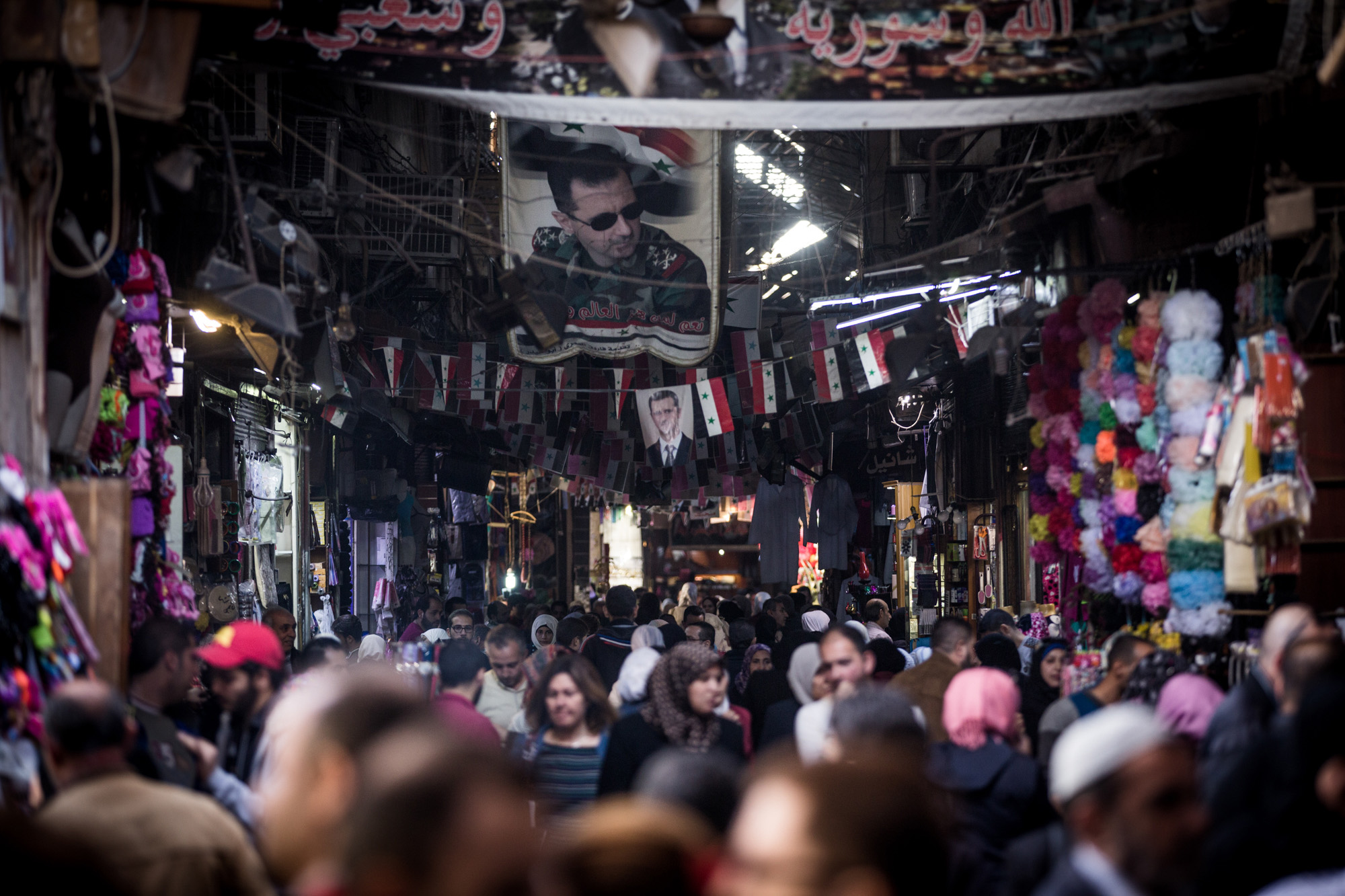
Damascus, Syria
Christian Werner
Part of the reason he went to Hama, Ford admitted, was to preserve his professional standing. Back home, his presence in Damascus was controversial. There hadn’t been an American ambassador there since Bush pulled the last one out in 2005. When Obama tried to appoint Ford, Senate Republicans blocked him. Rep. Ileana Ros-Lehtinen (R-Fla.), then chairwoman of the House Foreign Affairs Committee, called his appointment a “major concession to the Syrian regime.” Ford was sent to Syria as a recess appointment. Unless he gave Republicans a reason to believe he was tough on Assad, he would have to step down in a few months. If the regime attacked civilians in Hama, he would be there to witness it. “If this is what I saw with my own eyes, I would have enormous credibility,” he said.
In his hotel that night, Ford watched one of Assad’s advisers speak about him on TV. She was “screaming about the Americans inciting protests in Hama,” an assertion Ford found “ridiculous.” The next day, he and his team arrived at the city square two hours before the Friday protest was due to start. A thousand people had already gathered. “Because the Syrian government had been making such a big fucking stink about it, everybody in town knew we were there,” Ford told me. “We were surrounded by people immediately.” Protesters chanted, “The people want the fall of the regime,” and tossed olive branches and roses on his vehicle. “Our car literally couldn’t move,” Ford said.
Ford decided to get out of town before the Friday prayer ended and the protest officially began. About 500,000 people turned out for the demonstration, said to be the largest yet. The Syrian Foreign Ministry called Ford’s visit “clear evidence of the United States’ involvement in current events in Syria and its attempt to incite an escalation in the situation.”
Three days later, several buses parked near the American Embassy in Damascus. Ford watched through the security cameras as dozens of young men got off the buses and started protesting. They were soon joined by hundreds of people, some throwing rocks and eggs. Eventually, the men from the buses scaled the fencing around the embassy. They “went straight up it like they were trained commandos,” Ford recalled. The embassy went on lockdown while the intruders climbed onto the roof, took down the American flag, and hung a Syrian flag in its place. They burned the American flag in the streets.
Some of the men started pounding the iron door on the roof. The embassy’s Marines pointed their guns at the door from the inside. If the men broke in, the Marines told Ford, they would open fire. Ford called the foreign minister several times, but the police didn’t show up for three hours. The embassy later traced the buses; they belonged to a company owned by Assad’s relatives.
Three weeks later, the Syrian army moved into Hama, breaking through protesters’ barricades and raining shells on the city while soldiers fired on civilians. More than 100 people were killed. A similar scene unfolded in the eastern city of Deir Ezzor. The Syrian civil war had begun.
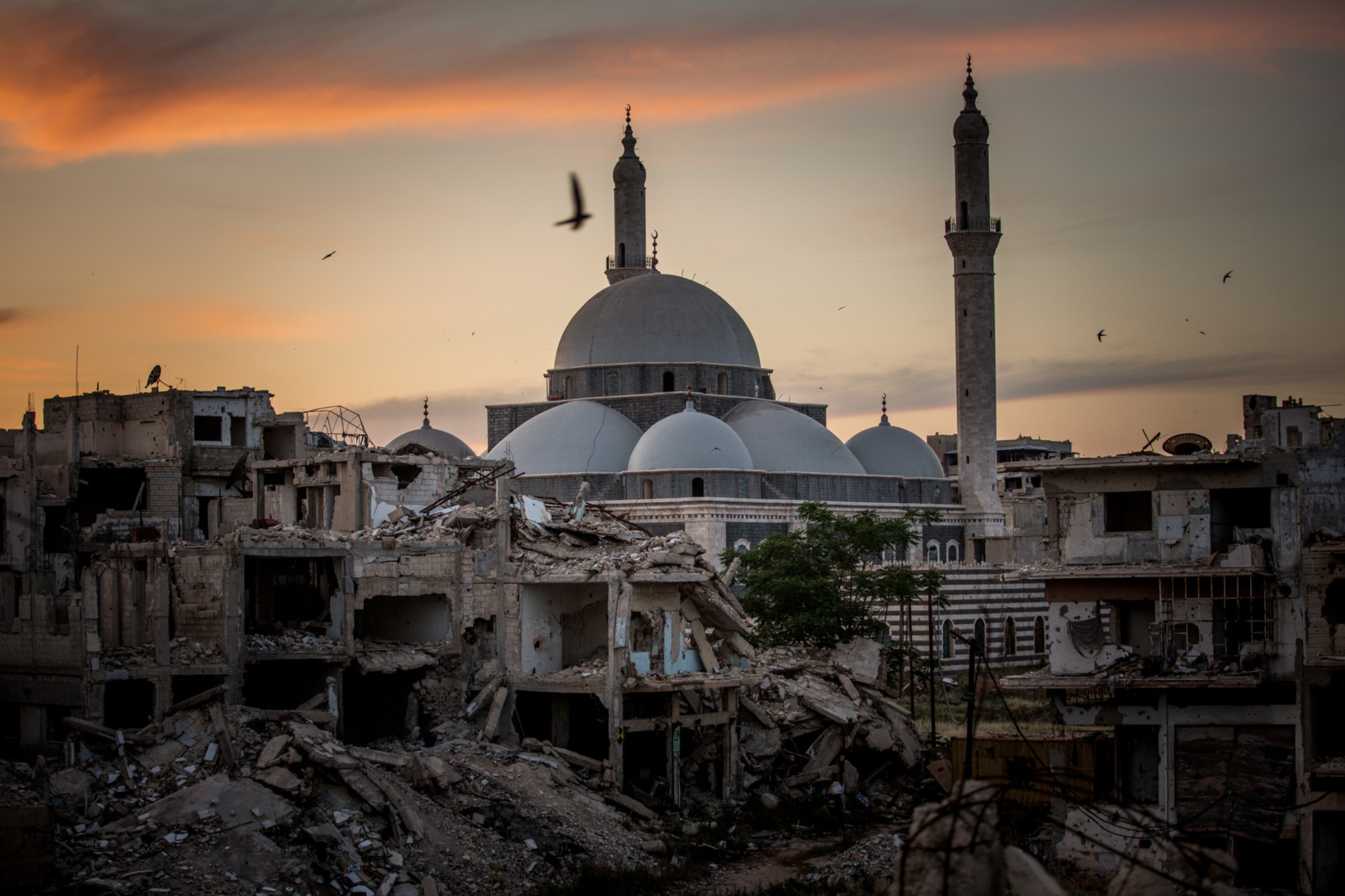
We pull up to Omar, Syria’s largest oil field. It’s an industrial ghost town, a heap of mangled pipes and charred oil tanks. The coalition has claimed part of it as a base. I ask the Kurdish guards if I can talk to the Americans. They say no.
Here the US special forces are just one player in a region full of international fighters. In addition to other coalition troops, there are the Russians and ISIS, many of whom are foreigners, as well as the Afghan Fatemiyoun mercenaries, Shiite refugees recruited by Iran’s Islamic Revolutionary Guard Corps. And there are the soldiers of fortune of the Wagner Group, a shadowy Russian Blackwaterlike private army that is said to have 2,500 fighters in Syria.
That so many outside combatants have clustered in the most remote part of Syria might have something to do with its significant oil and gas reserves. Before the war, Syria’s fossil fuel production was modest, but oil revenue made up roughly 25 percent of the country’s budget.
I tell my SDF escorts I’d like to stop by Syria’s largest gas field, a particularly fought-over prize. It’s known by the name of the American company that developed it—Conoco—and at various points it’s been under the control of the Syrian government, the FSA, an Al Qaeda affiliate, ISIS, and the SDF. Over the past two years, American- and Russian-backed forces have fought for control of Conoco and two nearby oil fields, each with air support from their superpower patrons. Out in the endless plains of sand and rock, we pass oil tankers rusting in the sun, possible ruins from Tidal Wave II, a 2015 operation in which American jets tried to put a dent in ISIS’s lucrative oil business. One of my escorts tells the driver to avoid stopping for any reason. He says their vehicle was shot at near the Iraqi border this morning. On the stereo, he plays a jihadist anthem. Like a punk rocker singing a country song he secretly likes, he sings along and snickers.
Sitting quietly in the back seat is Ahmed, a soft-spoken 30-year-old I’ve hired to help me navigate Deir Ezzor’s patchwork of territories. He knows there is a good chance the Syrian government will reclaim this part of the country, so he’s asked me to identify him by his first name only. Like many people here, he never thought he’d hope for American forces to take control.
Ahmed was once a noncommissioned officer in the Syrian army. He put on a mask to join the anti-Assad protests before the military occupied Deir Ezzor city in July 2011. Two weeks later, Ahmed was arrested, blindfolded, and loaded into a plane with 18 other prisoners. The officers beat them, shouting, “Who is your God?”
“Bashar!” the prisoners replied.
He worried they would drop him from the sky. Instead, he was taken to the air force intelligence prison in a ritzy part of Damascus. Interrogators accused him of plotting to steal weapons to massacre Alawites. They filled Ahmed’s mouth with salt, hung him from his wrists, and pulled out his fingernails. “The problem in prison is not confessing,” Ahmed says. “The problem is convincing them that your confession is genuine so they leave you alone.”
New prisoners brought updates from the outside world. “Obama said [Assad’s] days are numbered,” one announced. Some said NATO was going to intervene. Just a few days after Ahmed was arrested, Obama issued his first statement on Syria. “The future of Syria must be determined by its people,” he wrote, “but President Bashar al-Assad is standing in their way. His calls for dialogue and reform have rung hollow while he is imprisoning, torturing, and slaughtering his own people.” Assad, he said, “must lead a democratic transition or get out of the way.”
The inmates’ hopes rose. One day, a powerful explosion shook the floor. Ahmed heard gunshots. The prisoners started to bang on the walls and shout, “God is greatest!” They thought their moment of liberation had arrived. But the gunfire stopped and the guards ran in and beat them unconscious.
Ambassador Ford told me he wishes, in retrospect, that he had advised Obama against calling for Assad to step down. Even though the president had said the United States would not impose regime change on Syria, the “nuance in what Obama said…was totally lost.” It wasn’t just opposition activists like Ahmed who were banking on US intervention. Many in the budding armed opposition were certain they would soon receive support from the Americans. Ford insisted to them this would never happen, but “they just wouldn’t believe it,” he recalled. Obama’s statement “in the long run didn’t help anything. It probably made it worse.”
Obama had no plan to push Assad out. At that moment, his administration was busy juggling the NATO no-fly zone in Libya and unrest in Bahrain, where the United States has a major naval base. According to Philip Gordon, a former White House coordinator for the Middle East, Obama’s team believed Assad would be chased out by protests like other dictators were, so they “might as well align the United States on the right side of the conflict.”
After nine months in prison, Ahmed was released. He deserted Assad’s army and joined a Free Syrian Army brigade. Yet even as the FSA gained fighters and weapons, other armed factions were rushing into Syria’s power vacuum.
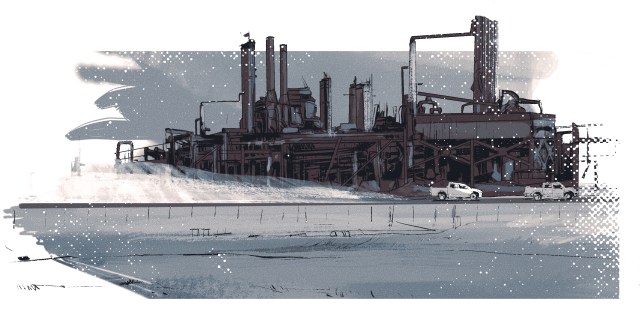
Just inside the compound, a sign reads, “Paradise is in the shadows of swords.”
Owen Freeman
In August 2011, eight men crossed the border with Iraq under orders from Abu Bakr al-Baghdadi, the leader of Al Qaeda in Iraq, to establish a new front in Syria. AQI had become a shadow of its former self. At one point, it had controlled large chunks of Iraq’s Sunni west, from which it launched attacks against American soldiers and Shiite civilians. In 2007, President George W. Bush’s “surge” sent an additional 20,000 US troops to Iraq. American forces partnered with local tribes, retook AQI’s territory, and killed most of its leadership. The growing chaos in Syria in 2011 presented AQI with an opportunity for rebirth. Its new Syrian organization was known as the Nusra Front. To avoid its parent organization’s bloody reputation, it would keep its affiliation with Al Qaeda secret.
Nusra established itself among a tribe in Deir Ezzor province known for sending men to Iraq to wage jihad against Americans. Assad had originally encouraged such adventures, but under intense diplomatic pressure, he had many extremists arrested when they returned home. Yet as Assad began locking up the nonviolent opposition in 2011, he released some Islamists. By doing so, he created a self-fulfilling prophecy. He had already claimed, falsely, that those protesting him were jihadist terrorists. Now a genuine, well-organized Islamist insurgency would help him legitimize his crackdown on the opposition.
Nusra’s leadership brought many of these Islamists into their fold. The group avoided the bloodthirstiness of Al Qaeda in Iraq, which had targeted Shiite mosques and sent suicide bombers into packed markets. Instead, it focused on integrating itself within the opposition. It also attracted fighters from other parts of the Arab world and former Islamist battlegrounds like Chechnya.
Washington could see what was happening but was conflicted about what to do. In February 2012, General Martin Dempsey, the chairman of the Joint Chiefs of Staff, told CNN, “I think it’s premature to take a decision to arm the opposition movement in Syria” because “there’s indications that Al Qaeda is involved.” Obama’s staff considered designating Nusra a terrorist group, but deputy national security adviser Ben Rhodes argued against it. “Al Nusrah was probably the strongest fighting force within the opposition,” he later recalled in his book. “I argued that labeling al Nusrah as terrorists would alienate the same people we wanted to help, while giving al Nusrah less incentive to avoid extremist affiliations.” Rhodes lost that battle, and in December 2012 the United States officially put Nusra on its list of terrorist organizations, saying it was a front for Al Qaeda.
From its stronghold in Deir Ezzor, Nusra focused on seizing the oil and gas facilities that could fund its operations. Middlemen reportedly sold the fuel in Turkey and areas held by Assad, making Nusra more financially independent from Al Qaeda. As Nusra gained strength and popularity, Baghdadi became worried that its commander, Abu Mohammed al-Jolani, was pulling away from his leadership. As he pressured Jolani to publicly declare his connection to Al Qaeda, he also wanted to make sure Nusra’s oil and gas reserves were firmly in his grip.
According to Mozahem al-Salloum, a defense intelligence researcher at a Syrian activist group, Baghdadi promised the Nusra commander who held Conoco a bigger cut of the profits if he would ally with AQI in the event of Jolani’s defection. In April 2013, Baghdadi told Jolani to publicize the Nusra-AQI link. When Jolani balked, Baghdadi announced the two groups would merge into a new organization under his leadership: ISIS. The bulk of Nusra’s foreign fighters went with ISIS, as did the commander of Conoco. Jolani pledged his allegiance to Ayman al-Zawahiri, the Egyptian who took over for Osama bin Laden after he was killed.
Tensions simmered over Conoco. In 2014, Nusra took it from ISIS. Then ISIS fighters rushed in, reclaiming Conoco and the rest of Deir Ezzor. Shortly afterward, ISIS announced the creation of the caliphate, its so-called Islamic State. Oil made ISIS one of the best-financed terrorist organizations in history. At its height in 2015, the group controlled 15 oil fields in Syria, 10 in Iraq, and at least a dozen natural gas fields. Its oil sales were bringing in as much as $50 million per month.
Ahmed’s FSA brigade was no match for ISIS’s well-financed, well-armed operation, so he and his comrades fled to Turkey. When the Pentagon attempted to raise a group of Syrian exiles to take back Deir Ezzor, American officers trained Ahmed how to use the new weapons they promised to provide. The project quickly fell apart, but in the fall of 2017, the SDF captured Ahmed’s village, and he returned home. ISIS had been pushed out, and that was the most important thing, but the possibility of Syrians determining the fate of their country was long gone.
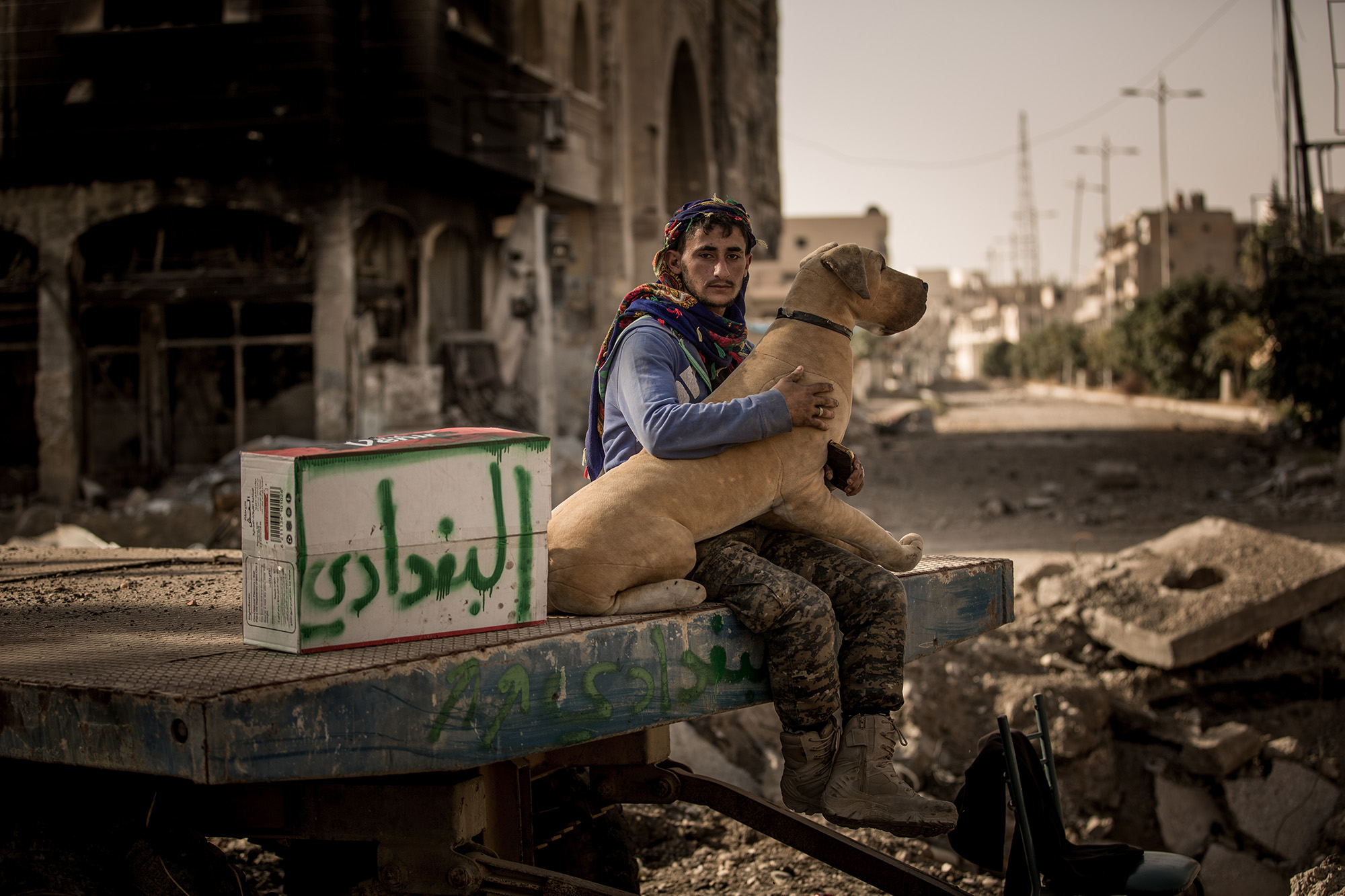
As Ahmed and I drive up the eastern bank of the Euphrates, our driver stops suddenly, puts the van in reverse, and backs up to a car parked on the side of the road. From the driver’s seat, a man with shoulder-length black hair looks at us. “Are you from ISIS? I swear to God, you look like one,” our driver says, half-smiling, pointing at the man. The man looks embarrassed.
“No, I’m not,” he says. “Go away.”
We drive off. “That guy snitched on my cousin and ISIS slaughtered him,” our driver says, making a sawing motion with his hand, like chopping off a head.
We drive to Ahmed’s favorite spot on the river, just north of Deir Ezzor city. Motorcycles bump down the country roads, winding between wheat fields that look golden in the afternoon light. Along the river, an old woman and three children tend a flock of sheep nibbling on the bright green grass. Our driver runs down to the water and jumps in, fully clothed, swimming against the current. Ahmed follows, and the two of them splash around.
A few hundred feet down the river, a couple of men stand outside a small cement shack with the yellow, green, and red triangular flag of the People’s Protection Units (YPG)—the Kurdish militia that leads the SDF—flying overhead. Everything east of the river, except for small remaining ISIS pockets, is controlled by the SDF and the US-led coalition. The land to the west is mostly controlled by the Syrian government, Iran, and Russia, though there are parts controlled by rebels, jihadists, and Turkey. The Russians and the coalition have mostly agreed to stay on their own sides of the river, but if problems arise they have a special “deconfliction” phone line for sorting things out.
I walk down to the water to take pictures. A member of the local defense forces walks speedily over to me. “Hurry up with that,” he says. “The regime has a position over there.” He eyes a distant building, barely a dot on the horizon. The government troops sometimes shoot across the river, he says. He is worried they may think I’m setting up a machine gun on my tripod. I pack up and we leave.
Neither the US military nor the SDF is at war with the Syrian government, or vice versa. The unofficial American policy has been the more people battling the Islamic State, the better. “We are here to fight ISIS as a coalition, but if others want to fight ISIS and defeat them, then we absolutely have no problem with that,” coalition spokesman US Army Colonel Ryan Dillon said in 2017. But the United States does have a problem with others getting their hands on Syria’s shattered oil and gas industry. In 2016, Assad’s oil minister met with his Russian counterpart and representatives of Russian oil companies in Moscow to discuss their investment in Syria. The war had caused the government’s oil production to fall off by 98 percent. Retaking the country would also mean retaking its energy infrastructure.
In September 2017, the Syrian army and its militias, backed by Russian airpower, broke into Deir Ezzor in a bid to end ISIS’s three-year hold on the city. The timing was perfect: The SDF and the coalition were pummeling ISIS in Raqqa, 85 miles away, attempting to take the symbolic prize of the caliphate’s capital. That battle was expected to last several more months. In the meantime, Russia could help Assad grab the oil. The army used Russian mobile bridges and amphibious vehicles to cross the Euphrates to capture the oil and gas fields from ISIS. The next day, SDF fighters, supported by American jets, peeled away from Raqqa and stormed through the desert toward Deir Ezzor and Conoco. The SDF withstood a Syrian and Russian barrage to take the gas field. A month later, Syrian forces tried to take the Omar oil field from ISIS. The SDF raced through the desert and snatched it up first.
Abdelkareem Malek, the Democratic Federation of Northern Syria’s de facto energy minister, told me its fields in Deir Ezzor are badly damaged and running at no more than 20 percent of their prewar capacity. Still, oil and gas are some of the federation’s main sources of funds. Most of the fuel is used internally, Malek said. The rest is sold to areas under regime control.
Malek said no contracts had been signed with foreign companies yet, but “there have been many overtures made.” The country that “stands by our democratic, federalist project will certainly have priority when it comes to contracts,” he said.
“Do you mean the Americans?” I asked.
A silver tooth peeked through his smile. “As the Eastern saying goes, a favor begets a favor in return.”
The final battle for Conoco took place a few months after the SDF drove out ISIS. In early February 2018, American soldiers watched warily as hundreds of heavily armed pro-Assad fighters gathered near Conoco over several days. American officers called the Russians over the deconfliction line to remind them that the coalition and the SDF held the area. On the evening of February 7, the attackers hit the SDF and US special forces with rockets, mortars, and tanks as they advanced toward the gas field. The Americans again called the Russians, and according to then-Defense Secretary James Mattis, “the Russian high command assured us it was not their people. And my directive…for the force then was to be annihilated. And it was.”
For three hours, the Americans fought back with artillery, helicopter gunships, and jets. The Euphrates Post, a local news site, reported that the attackers included Syrian security forces and Pakistani and Afghan Shiite militias. Tribal militias joined the assault, including local branches of the Iranian-backed Baqir Brigade led by a sheikh who had once received US support for an anti-ISIS militia before siding with Tehran. A significant part of the force was made up of Russian mercenaries, likely from the Wagner Group; a contract obtained by the Associated Press stipulated that Wagner would receive a quarter of the profits of any oil field it seized from the Islamic State. Afterward, reports surfaced that American soldiers had killed dozens, if not hundreds, of Russian mercenaries.
Careful to avoid invoking the Iraq War’s association with blood and oil, Pentagon officials sidestepped any mention of Conoco as they described how the attackers were repelled. Mattis merely said “pro-regime forces” had targeted “SDF headquarters,” adding, “I have no idea why they would attack there.” Asked if Russian mercenaries had been involved, Lt. General Jeffrey Harrigian, the commander of the coalition’s air operations, replied, “I don’t want to speculate on who was down there.” Though it also didn’t get into the details, the Russian Defense Ministry was more blunt, saying the incident “shows that the United States’ illegal military presence in Syria is actually aimed at taking control of the country’s economic assets and not at fighting against the [ISIS] international terror group.”
Large domes rise out of the earth as we near the Conoco plant. A couple of SDF fighters stand watch atop dirt berms. One points across the desert to a building less than a mile in front of us. “That’s a regime position,” he says. He points to another spot. “The Russians were in that house over there.” The area between us and them, he says, is full of mines.
A Kurdish officer reviews my paperwork and nods. He orders the other fighters to check our car for bombs and tells us to come with him inside. We follow the dirt road into the gas plant. Just inside the compound, a sign, presumably left over from ISIS, reads, “Paradise is in the shadows of swords.” One of the Kurds tells us to wait. Armored vehicles are parked up ahead. An American flag flies above everything. Are the special forces here?
When the Kurdish officer returns, he says we have to leave. After beating back the Russian mercenaries and Syrian militiamen three months ago, my escort says, the Americans turned the Conoco gas field into a military base. The SDF has approved our visit, but the coalition said no journalists are allowed. The US military, it seems, still jealously guards its prize.
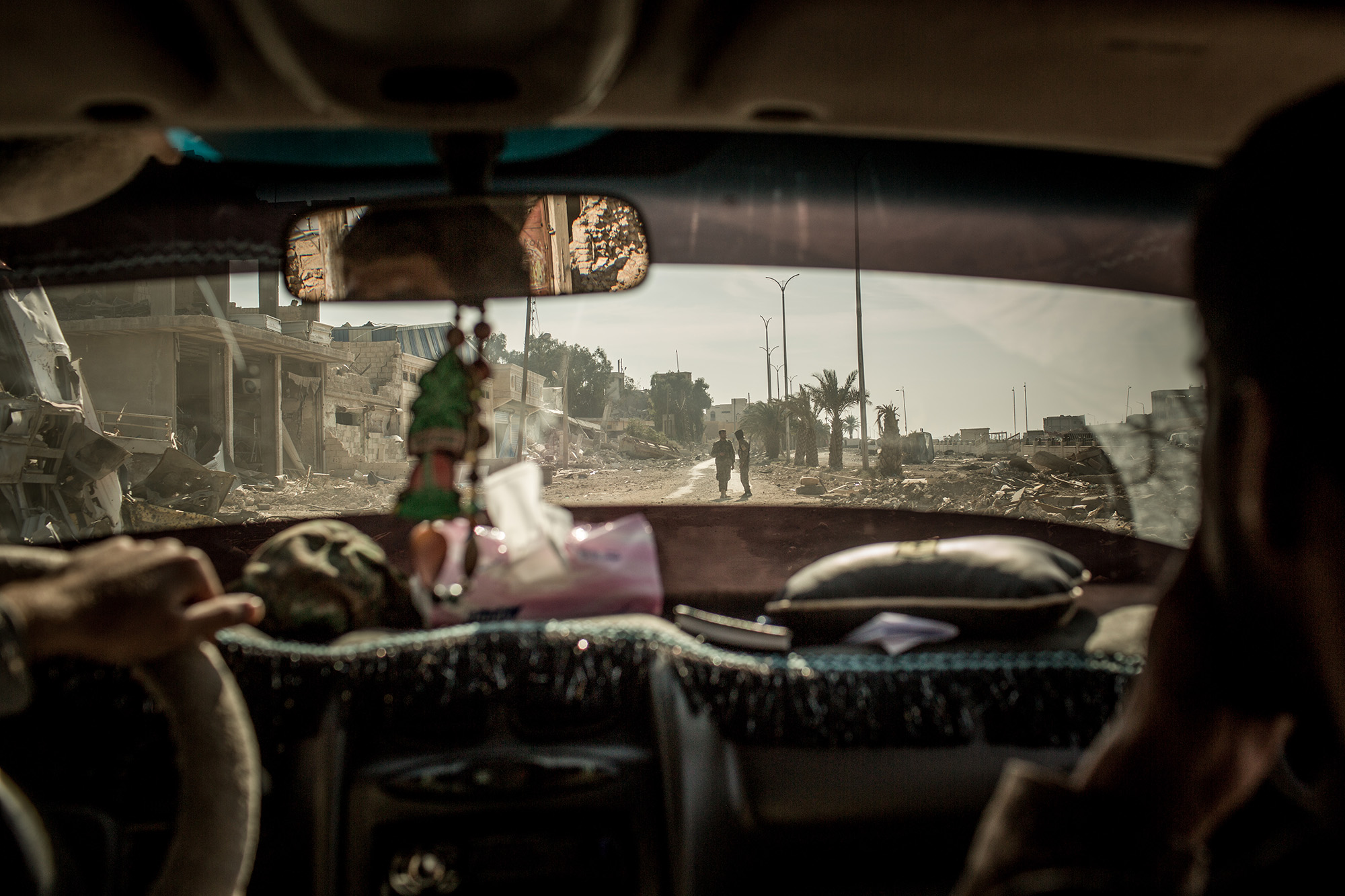
It also helped when he got arrested. In jail, he was beaten and spit upon, but they didn’t curse his family, burn him with cigarettes, or electrocute him. His captors knew he had personal connections. When his dad, a former high-ranking intelligence officer, got him out after just a week, Artino signed a paper promising to stop his opposition activity. His father scolded him for associating with a bunch of violent drug addicts.
But Artino continued his activism. When relatives saw him on television at the funeral of an opposition activist, his brother, an officer in the Syrian army’s feared 4th Division, sent him a message threatening to kill him. Shortly afterward, the secret police came to Artino’s workplace, but he pretended to be someone else and got away. Another day, he was approached by a man who said he was an intelligence agent assigned to monitor Artino’s movements, but since he was friends with Artino’s cousin, he offered to report nothing if Artino agreed to lie low.
Artino went to his aunt and uncle’s summer home in Ghouta, a semirural area outside the capital where the government had less control. At night, FSA fighters would attack military checkpoints there, blending back into civilian life during the day. In August 2012, Artino heard shouting and gunfire outside. When he opened the door, he saw soldiers from what looked like the Republican Guard, a division that protects President Assad, searching for activists and rebels, shooting anyone who ran. Artino began burying his laptop outside when he wasn’t using it. He planned to disguise himself in a burqa if the military suddenly showed up.
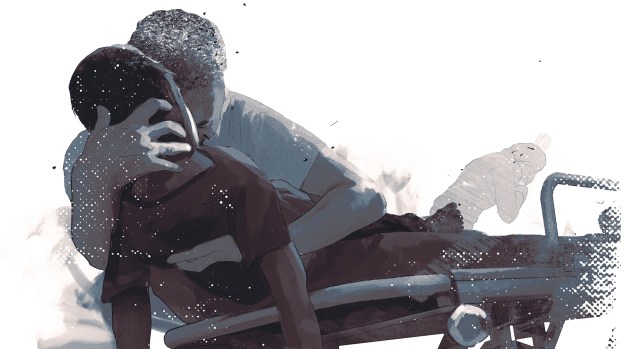
He clutched the boy’s limp body to his chest. Then he screamed.
Owen Freeman
As things got dicier, Artino fled to Lebanon for a couple of months, but he decided it was safe to return after the rebels started to take over towns in Ghouta. By the time he got back, things had changed. It felt like “living in a free country without dictatorship, without mukhabarat,” Assad’s feared secret police. “It was like heaven to us. You could really express what you want, and you can go and take pictures and protest and do civil activities and everyone was supporting you.”
On his way back to Ghouta, Artino had hitched a ride with smugglers and the FSA. One of the other passengers was Goran Tomasevic, a Serbian photographer who started his career taking shots of his own country as it was ravaged by civil war. “He showed me his pictures, and I was really overwhelmed,” Artino recalled. “I’m meeting the guy who took pictures of the Saddam statue, of the Libyan war. It’s like meeting a celebrity like George Clooney or something.” Tomasevic hired Artino as an assistant and trained him to shoot for Reuters.
As the government attacked eastern Ghouta, the two would embed with FSA fighters. That’s where Artino first saw the government use unconventional weapons. Once, when he and Tomasevic were on the front line, a plane fired a missile that sucked all the air out of the building they were inside, toppling it seconds after they got out. It seemed like they’d just survived a thermobaric bomb, which creates a massive pressure wave that can bring down entire structures. One day while Artino was photographing the front line, a grenade exploded nearby, temporarily paralyzing him and nearly everyone around him. He could see and hear but couldn’t move for what seemed like 15 minutes.
It was no secret that the Syrian government possessed chemical weapons. The US director of national intelligence had reported to Congress that Syria had stockpiled them, including the nerve agents sarin and VX. In July 2012, Syria stopped short of admitting its military had chemical weapons but warned that even if it did have them, they would be “used only in the event of external aggression.” A month after this nonadmission, Obama was asked by a reporter whether he would take military action against Syria if it used chemical weapons. “We have been very clear to the Assad regime,” the president said, “that a red line for us is we start seeing a whole bunch of chemical weapons moving around or being utilized. That would change my calculus.” Russia’s foreign minister said he didn’t think Assad would use chemical weapons. “It would be political suicide for the government if it does,” he said.
On December 23, 2012, videos appeared of men in a hospital in Homs violently gasping and vomiting from what doctors on the scene said was some kind of chemical attack. Over the next four months, there were reports of chemical attacks on rebels and civilians near Damascus and Aleppo and in other towns. According to a former White House official who asked not to be named, American intelligence occasionally got reports in advance that the Syrian government might use chemical weapons. “We were going to the Russians in real time and saying, ‘You better stop them from doing this.’” It didn’t seem to work. By July 2013, the United States, France, the United Kingdom, and Qatar had filed complaints with the United Nations about at least 12 separate chemical attacks believed to have been launched by the Syrian government.
In June 2013, deputy national security adviser Ben Rhodes issued a statement saying the intelligence community had determined that the Assad regime had used chemical weapons, including the nerve agent sarin, “on a small scale against the opposition multiple times in the last year,” killing an estimated 100 to 150 people. (A UN investigation later confirmed sarin had been used in several places in Syria.) The Obama administration, which had already committed $250 million in nonlethal aid to the Syrian opposition, including food, medical supplies, body armor, and night vision goggles, said it would expand its support for anti-Assad forces. The following month, congressional intelligence committees approved sending CIA weapons to the Syrian opposition.
The CIA and the State Department had wanted to arm the rebels for a while. The idea was first proposed by Secretary of State Hillary Clinton, Secretary of Defense Leon Panetta, and CIA Director David Petraeus in the summer of 2012. Obama had refused, but he let the CIA provide logistical support to other countries’ efforts to arm the rebels. “It was a clusterfuck,” says a CIA field operative who was on the Syria task force at the time. (He asked that I not use his name.) Turkey, Saudi Arabia, and Qatar had their own programs to support the rebels. “Everyone was providing their own funding, supporting whoever they wanted.” In 2012, the CIA operative provided training to Syrian rebels and worked with regional intelligence agencies to organize the flow of arms. “I said, ‘Guys, we need a plan. We need to coordinate.’ Nobody wanted to take any orders from me.” Without telling the Americans, “the Qataris would just go and drop a ton of guns to a group we didn’t know. You don’t think these guys are stockpiling? I’m thinking about Iraq, where we just blew things up and didn’t think about what was next.”
The decision in the summer of 2013 to directly arm the rebels may have had just as much to do with an escalating proxy war against Iran as it did with Assad’s use of chemical weapons. For more than a year, the Free Syrian Army had controlled al-Qusayr, a strategically important town near the Lebanese border and the highway between Damascus and the port of Tartus. In May 2013, al-Qusayr came under an assault led not by the Syrian army, but by Hezbollah, the Lebanese militia with decades of experience in guerrilla warfare. In less than three weeks, al-Qusayr fell to the regime. It was Hezbollah’s first major offensive in Syria, and many Syrians felt betrayed to see an organization they had revered for its opposition to Israel now acting as an occupier. Thousands of Hezbollah fighters were said to have entered the country to help the regime retake Aleppo and other opposition strongholds.
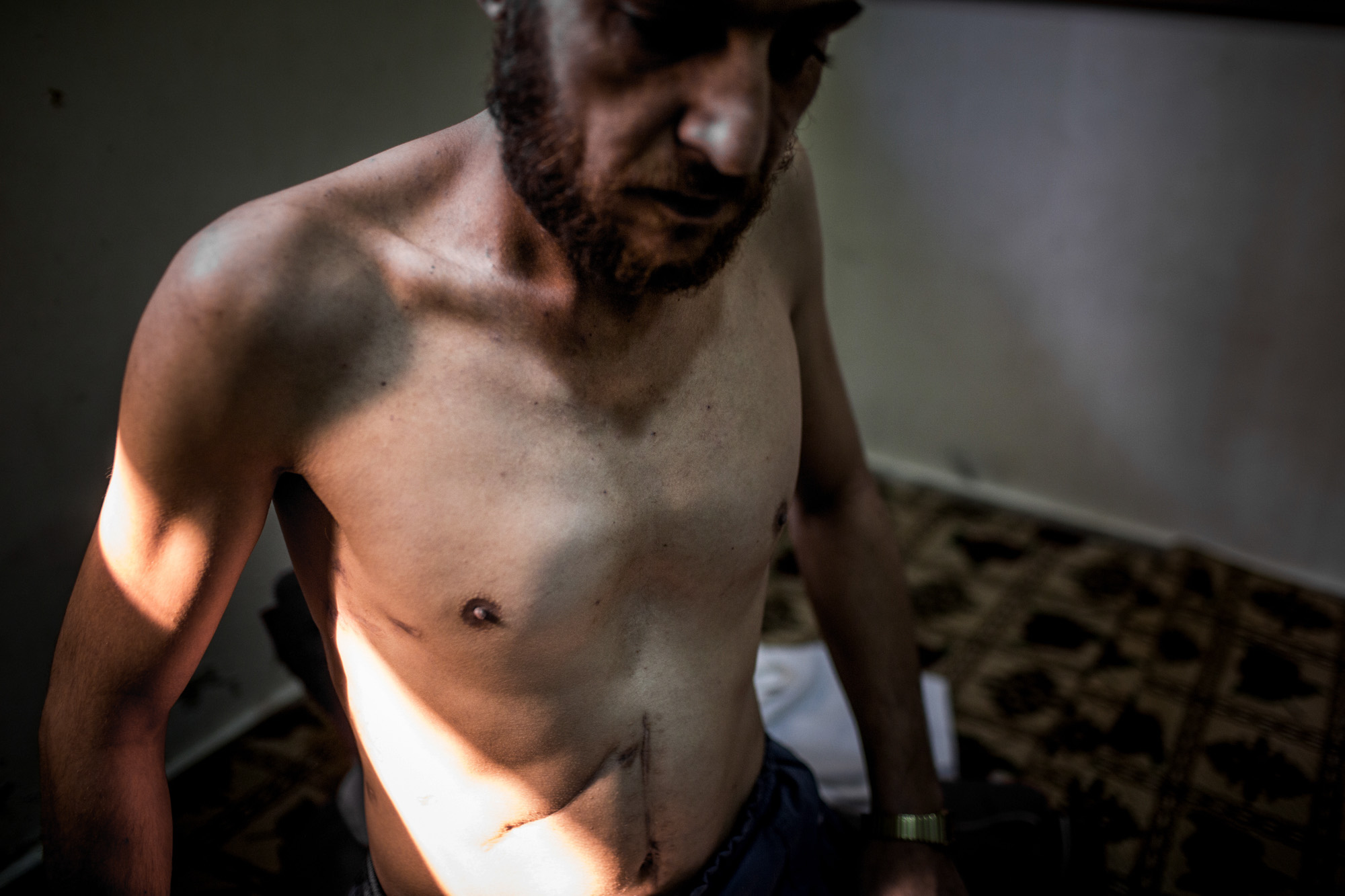
Ali Aswad, a 33-year-old displaced man in Damascus
Christian Werner
In Washington, Hezbollah’s involvement was seen as evidence of Iran putting its finger on the scale. “If someone was going to get rid of the regime, more support for the opposition was going to be necessary,” Philip Gordon, the former White House coordinator for the Middle East, told me. “The question became at that point, ‘What can we do to accelerate the process of getting rid of him?’” White House national security officials started to discuss possible “accelerants” to speed Assad’s demise, including establishing a no-fly zone, providing anti-aircraft weapons to the rebels, and launching airstrikes against Assad’s residences or offices. It also considered imposing sanctions on the Russian oil company Rosneft to send a message to Syria’s most powerful patron.
In June 2013, one month after Hezbollah’s attack began, the White House publicized the intelligence community’s findings on chemical weapons and Obama decided to arm the rebels. The president was “killing two birds with one stone,” Gordon said. He could show that he was responding to Assad crossing the “red line” and further the US agenda of forcing him out of power while pushing back against Iran. If drawing the Americans deeper into the war made Assad think twice about his next move, he didn’t show it.
The images that poured out of eastern Ghouta in the early hours of August 21, 2013, were hellish. Men with water hoses were spraying down the victims of a chemical attack. People writhed on the floors of hospitals, mosques, and schools. Others were running around senselessly, screaming and pleading to God. There was no blood anywhere, but hundreds of people were clearly dying.
A girl with sunken eyes lay on a hospital floor, unmoving except for periodic, slow gulps of air. A boy’s arm wandered jerkily above him, gesturing in circles as his legs, chest, and the muscles around his vacant eyes twitched violently. A man shrieked and flopped around like a fish fighting for life, and a naked girl clutched her head, her face full of terror, saying “I’m alive,” over and over. On a hospital bed, a man pumped the chest of a small, lifeless boy until foam leaked from the child’s mouth. He clutched the boy’s limp body to his chest. Then he screamed.
“It’s like a mental hospital,” Artino thought as he walked through a hospital, taking photos. A girl sat on a bed repeating the words “Why am I here? Where is my mom?” as her mother looked at her with a terrifying smile. “It’s okay, my love,” the mother said. “Everything is going to be fine.” A boy repeated a refrain about how he was at a play rehearsal and now his parents were dead.
Survivors told Artino that when the rockets hit around 2 a.m., they initially thought they might be chlorine bombs. It was the perfect time of day for a chemical attack—the cooling ground would draw the poison gas downward. Imams called from the mosques for people to run up to their roofs. But then mortars rained down, driving people back inside and into the deadly gas.
Artino walked into a room where babies were sleeping on the floor in their pajamas. He stopped and stared at them. The babies were not sleeping; they were dead. His camera fell from his hand and he began to sob. He had seen many people killed over the past year, but he’d never seen anything like this. Grabbing one of the little bodies, a doctor showed Artino the dark blue skin, the foaming mouth, the shrunken pupils: symptoms of sarin poisoning. When the doctors in Ghouta had heard sarin was used in Aleppo and on the outskirts of Ghouta earlier in the year, they learned to use smuggled atropine, an antidote, but they had nowhere near enough.
“I need to take pictures,” Artino said to the doctor. “To show this is not a normal fucking attack.”
He got down on the floor, up close to a dead boy, and began taking photos. Suddenly, he could barely breathe. A burning sensation shot through his lungs. His vision disappeared and he collapsed. He was taken out of the room and injected with atropine. When he woke up a short while later, the world was spinning. As soon as he got his bearings, he left the hospital and sent his photos to Reuters.
The sarin attack on Ghouta was the deadliest single incident in the Syrian conflict at that point. Doctors Without Borders reported that about 3,600 patients were treated for symptoms consistent with exposure to a neurotoxic agent at three hospitals it supported. Of those, 355 died. The US government said 1,429 people were killed, nearly a third of them children. The red line had unambiguously been crossed.
Back in Washington, it still wasn’t clear what that meant. While the CIA had been eager to get involved in Syria, the Pentagon had been reluctant until now. Yet in the White House Situation Room meeting the day after the attack, “there was broad agreement around the table that a military response was appropriate,” then-Secretary of State John Kerry wrote in his memoir, Every Day Is Extra. Kerry, Defense Secretary Chuck Hagel, national security adviser Susan Rice, and Martin Dempsey, chairman of the Joint Chiefs of Staff, advised Obama to order a military strike. They believed it would be the most effective way to deter Assad from using chemical weapons again. Kerry thought missile attacks would help bring about an “endgame” in Syria—while putting Iran on notice. The momentum for a military strike “felt energizing,” Rhodes, who had long favored intervention, wrote later, “as though we were finally going to do something to shape events in Syria.” (Rhodes, Rice, and Dempsey declined to be interviewed for this article. Kerry did not respond to an interview request.)
Director of National Intelligence James Clapper was more cautious. In a morning briefing a few days after the Ghouta attack, Clapper said the case that Assad had ordered the chemical attack was not a “slam dunk,” using air quotes for emphasis, according to Rhodes. That was the same phrase former CIA Director George Tenet had used to assure George W. Bush that Saddam Hussein had weapons of mass destruction. Clapper apparently didn’t want the responsibility for another war in the Middle East to fall on the intelligence community. “Jim,” Obama interjected, “no one asked you if it was a slam dunk.”
Obama ordered military options to be prepared. But there was a hitch: UN inspectors were already in Syria investigating earlier allegations of chemical attacks. Obama asked UN Secretary-General Ban Ki-moon to pull the inspectors out of Syria, but Ban insisted they finish their investigation. “To this day, I wonder if Obama would have launched a strike early that week if the UN team hadn’t been in the way,” Rhodes later wrote.
On the day before the UN team left Syria, the White House said it had assessed with “high confidence” that the Assad regime had ordered the nerve agent attack on Ghouta nine days earlier. Yet Obama did not order a strike. Congressional Republicans who had accused him of being weak on Syria were now warning him against military action. Ninety-eight Republican House members and 18 Democrats signed a letter urging the president to request congressional approval to use force in Syria. And while British Prime Minister David Cameron believed military action was necessary to prevent further war crimes, Parliament voted against joining US-led strikes. “The well of public opinion has been well and truly poisoned by the Iraq episode,” Cameron said.
Meanwhile, conspiracy theories about the attack flourished. Assad’s political adviser not only blamed the rebels for the attack but came up with a colorful story that fit the regime’s sectarian narrative. The rebels, she said, had kidnapped Alawite men and children, “put them in one place, and used chemical weapons against them.” Russian President Vladimir Putin suggested the attack was “a provocation” meant to draw other countries into the conflict. Rep. Ron Paul (R-Texas) called it a “false flag” operation to suck the United States into “strife that’s been going on in that region for thousands of years.” In two widely discredited articles, journalist Seymour Hersh would later suggest that Nusra and the Turkish government were behind the attack. Rush Limbaugh talked up an article claiming the White House had known the Syrian opposition might launch a chemical attack but didn’t act to stop it so that military intervention could be justified.
Three weeks after the attack, the United Nations released the results of its investigation, which had found conclusive forensic evidence that sarin had been used in Ghouta. While the UN team was not tasked with assigning responsibility for the attack, its report provided evidence that the gas had been launched in rockets fired from the direction of a nearby Syrian military complex. Each warhead could hold about 15 gallons of sarin. If opposition forces were behind this attack, they would have had to come up with a massive quantity of sarin with no one noticing, put it into munitions identical to those the regime possessed, fire them from regime-controlled areas northwest of Ghouta, and slip away without being caught. The sarin used in Ghouta was high quality, according to Åke Sellström, the head of the UN inspection team. The attack had the “signature of someone that knows how to do this and has the resources,” he told me. “To me, it points to the government.” Human Rights Watch also determined that “Syrian government forces were almost certainly responsible” for the attack.
Meanwhile, Kerry was in frequent communication with his Russian counterpart, Foreign Minister Sergey Lavrov. Kerry insisted the United States had unimpeachable intelligence implicating Assad in the chemical attack. Lavrov needled Kerry about whether the intelligence might be faulty and warned him against striking Syria without international support. Kerry broached the topic of their two countries pressuring Assad to get rid of his chemical weapons, but Lavrov waved it off as “too risky.” At a G-20 meeting in Russia in September, Obama and Putin had a private conversation about working together to remove and destroy Syria’s chemical weapons. A few days later, Lavrov told Kerry that Moscow was prepared to publicly take him up on his offer. Inwardly, Kerry later admitted, he regretted that the United States had lost the opportunity to use airstrikes to rally the international community to cooperate to finally oust Assad.
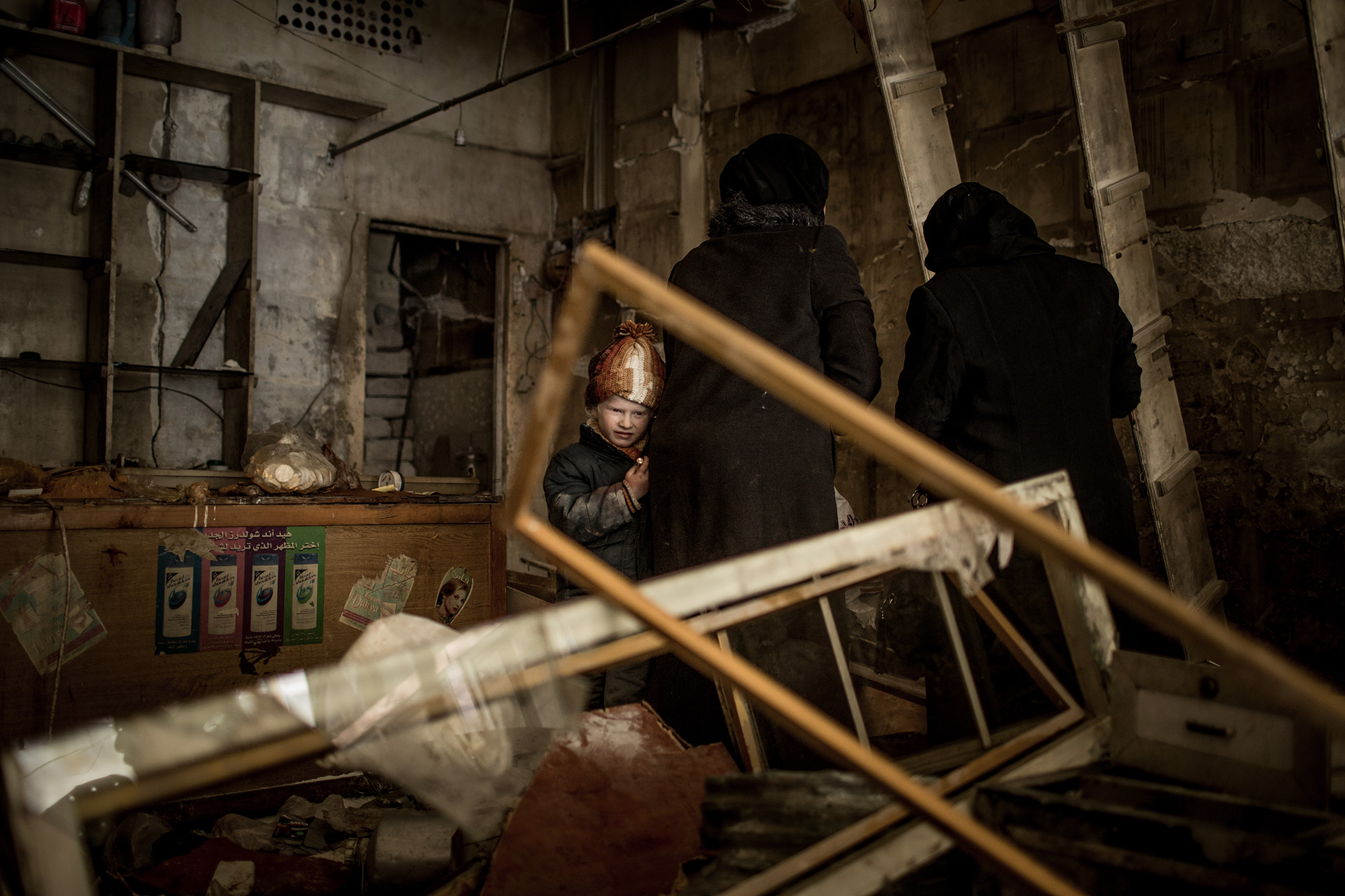
In the weeks following the sarin attack, Ghouta was like “a city of ghosts,” Artino recalled. “We didn’t even have funerals because the number was just too huge. We were still trying to survive and get out of the tragedy.” For months, Assad had been attempting to cut Ghouta off from the rest of the world. Electricity was shut off, no vegetables were let in, and civilians couldn’t enter or leave. People were going hungry.
Then came word that Obama would make a speech. As Ghouta’s residents anticipated his remarks, “you [could] see it in people’s faces: They have hope. We need this,” Artino said. “We need someone to really defend us. A big nation, like the USA. Even children were sitting next to their families and looking at a TV, waiting for Obama to say, ‘We are going to attack Assad’s regime.’”
On September 10, Obama laid out details of the chemical attack and said he wanted Congress’ approval for military action in the event that a deal with Russia couldn’t be struck. Such intervention was not popular. Even Sen. Marco Rubio, who for two years had called for the administration to step up support for anti-Assad rebels, spoke out against an assault. Donald Trump tweeted that Obama wanted to strike Syria “to save face over his very dumb RED LINE statement.” A Gallup poll showed that just 36 percent of Americans supported an attack. Domestic politics had tied Obama’s hands—and offered a justification for inaction.
[Read why and how we sent a reporter to Syria]
“We were so pissed off,” Artino said. “We lost hope. Obama, the most powerful person in the whole world, didn’t even want to do anything to Bashar. We just said, ‘You know what? Fuck off. We are just going to continue doing what we are doing, which is survive.’ Trying to dig for water. Trying to create solar panels. We started to make bread from corn. We started to eat anything.”
Perhaps believing Washington might still attack Syria and tip the balance of the war back to the rebels, Russia pressured Assad to surrender his chemical weapons. By September 2014, roughly 1,300 tons of chemical weapons had been removed from Syria and incinerated.
Internationally, the process was viewed as a diplomatic success—had the United States bombed Syria, Assad would have held on to his chemical weapons. But while sarin, mustard gas, and VX nerve agents were hauled out of Syria, the government continued to bomb civilians with barrel bombs and chlorine, an internationally prohibited chemical weapon. One study found there have been more than 330 chemical attacks during the Syrian war. Ninety-eight percent were launched by the Syrian government, the rest by the Islamic State. About 90 percent of confirmed attacks occurred after the sarin attack on Ghouta. The vast majority involved chlorine, but it would become clear that Assad had not given up on using sarin.
As Ghouta faded from the world’s attention, the siege wore on. Artino’s home was bombed. Local rebel commanders started to act more like warlords, taking control of smuggling routes and driving food prices even further out of reach. At one point, rice sold for roughly 20 times the price in Damascus. Artino’s weight eventually dropped from 200 to 120 pounds. He became so undernourished that his right hand stopped working, so he learned to take pictures with his left hand. A veterinarian gave him vitamin B injections meant for cows, and his arm slowly came back to life.
Foreign fighters showed up, and Islamist factions began fighting each other for control. As Artino walked past a jail run by the group Jaysh al-Islam, now one of the most powerful militias in Ghouta, he heard screams. Some of Syria’s most prominent activists had disappeared in Ghouta, almost certainly abducted and executed by Jaysh al-Islam. Not long after a car bomb exploded at a market while he was shopping, Artino decided to leave. He fled to Lebanon and later received refugee status in Belgium.
Congress has still not voted to allow US force in Syria. (The military has waged its campaign against ISIS under the post-9/11 authorization to use force against Al Qaeda.) In April 2017, the Syrian government killed dozens of people in the town of Khan Sheikhoun with sarin. In retaliation, Trump launched a missile attack against a regime air base. He alerted some members of Congress but did not ask for their approval. While Republicans had scolded Obama for not being tough on Assad, only to tie his hands when he sought to enforce his red line, they now stood aside. Rubio praised the president for making “it clear to Assad and those who empower him that the days of committing war crimes with impunity are over.”
In April 2018, the Syrian military dropped a chlorine bomb on a building in eastern Ghouta, killing more than 40 people. Trump responded with missile strikes on a chemical weapons research center and two chemical weapons storage facilities. A majority of Americans said they supported the strikes. The president tweeted, “If President Obama had crossed his stated Red Line In The Sand, the Syrian disaster would have ended long ago!” Less than a week later, the Syrian army declared it had recaptured eastern Ghouta.
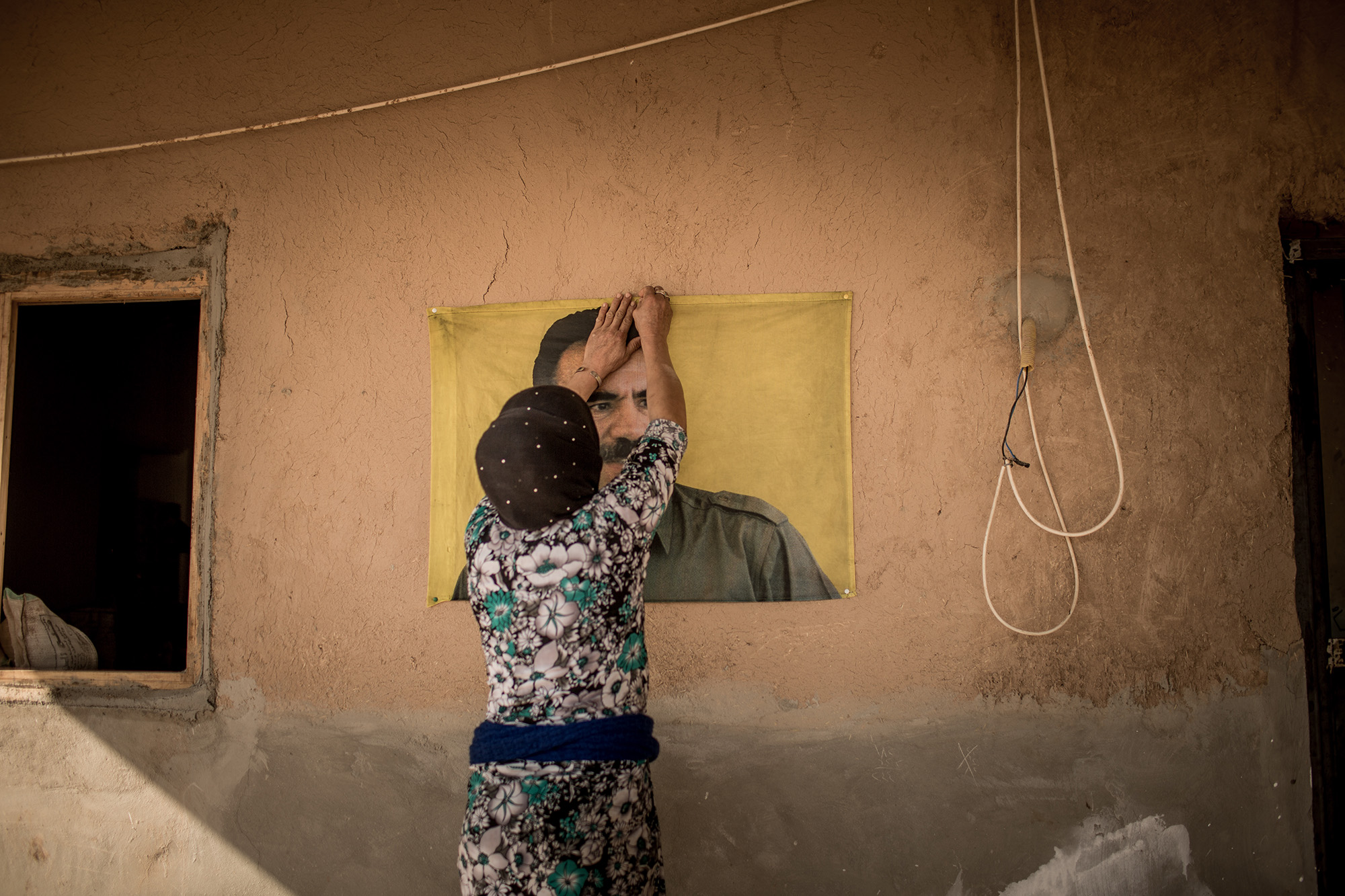
“Nowhere in particular,” he says in a sulky voice. “I might be vague about some personal stuff.” He asks that I call him Berxwedan, the Kurdish word for “resistance,” but to keep it simple, I’ll just call him Barry. Barry wears a black and red anarcho-syndicalist patch on the arm of his uniform. He and his comrades ask me not to take pictures, and they decline my request to visit their base in a nearby town that was retaken from ISIS. Instead, we drive to a quiet kebab shop to talk.
Barry has been a volunteer fighter with the Kurdish YPG forces for more than the six months he’d signed up for. It is, he thinks, “the best thing someone who considers themselves a militant leftist can do right now with their life.” This is his first time in the Middle East. Back in the United States, Barry was part of the antifa movement. He would brawl with fascists, sometimes carrying a concealed gun to protests “just in case.” It was in these circles that Barry first heard about Rojava, the semi-autonomous Kurdish region in northeast Syria that has become a cause célèbre in anarchist circles. Its name means “the west,” referring to the western part of the stateless Kurdish homeland that straddles Syria, Turkey, Iraq, and Iran. Those governments have repressed the Kurds’ long-standing desire for independence, with measures ranging from a ban on the Kurdish language to Saddam Hussein’s extermination of as many as 182,000 Kurds in the 1980s.
The ideological inspiration for the Rojava project is Abdullah Öcalan, the founder of the Kurdistan Workers’ Party (PKK). When Barry first encountered Öcalan’s writings back home, certain ideas spoke to him. For Öcalan, capitalism was an “inherent component” of the nation-state. What was needed, he argued, was “democracy without the state.” “I saw it as an anarchist revolution,” Barry tells me.
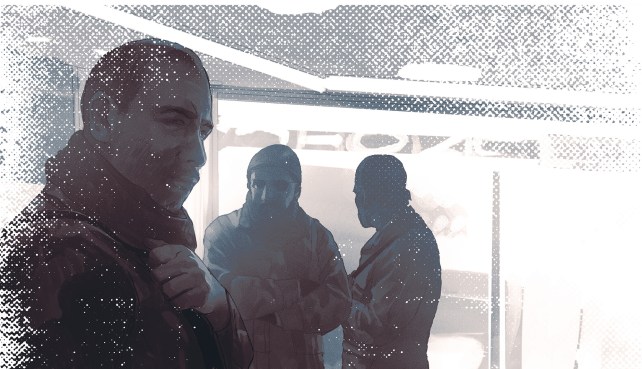
“The US is the single biggest source country” for Western fighters in the YPG.
Owen Freeman
Today, it is nearly impossible to drive down a street in the Kurdish parts of Syria without seeing Öcalan’s face smiling through a bushy mustache. He is stenciled on walls, plastered on billboards, and stuck on cellphone cases. The United States considers his group a terrorist organization, but his image is often patched on the uniforms of the militiamen who guard coalition bases and carry weapons provided by the Americans.
In 1980, Öcalan fled his home in Turkey for Syria. The Assad regime was repressing the rights of its Kurdish population, but it allowed Öcalan to form training camps on Syrian soil. From there, his guerrillas directed attacks against Syria’s enemy Turkey in pursuit of establishing an independent Kurdish communist state. In 1997, the United States labeled the PKK a terrorist organization, and the following year Hafez al-Assad kicked out Öcalan. With help from the CIA, Turkish intelligence captured him in Kenya in 1999.
Öcalan was sentenced to death for treason and separatism. His punishment was later commuted to life in prison, and for years he was held in solitary confinement as the only inmate of an island prison guarded by more than 1,000 military personnel. He read voraciously and became inspired by writers like Michel Foucault and Immanuel Wallerstein. None influenced him more than Murray Bookchin, an obscure anarchist thinker from Vermont. Bookchin criticized the traditional left for being slavishly bound to Karl Marx’s century-old class-centered ideas. (He once denounced Burlington Mayor Bernie Sanders as a “centralist” who ran a “civic oligarchy.”) His two dozen books had little to do with ethnic nationalism, Syria, or Turkey. Mostly, they mused about theoretical and political frameworks for the anti-authoritarian left.
Öcalan was particularly taken by Bookchin’s 1982 book, The Ecology of Freedom: The Emergence and Dissolution of Hierarchy, which proposed the creation of an egalitarian “ecological society.” In 2004, Öcalan wrote to Bookchin, seeking to apply his ideas to the Middle East. What interested Öcalan most was Bookchin’s ideology of communalism, in which central governments would be replaced by loose federations of autonomous communities. Öcalan wrote a new manifesto, Democratic Confederalism, which blended Bookchin’s ideas with those of the growing Kurdish feminist movement. (Bookchin died in 2006.) He also ordered his guerrillas to stop attacking the Turkish government. Rather than agitating for a communist state, Öcalan was now calling for a bottom-up system in which “decision-making processes lie with the communities.”
While Öcalan sat behind bars, his followers in Syria continued to organize. In 2003, they founded the Democratic Union Party (PYD), whose ideology was identical to the PKK’s, though it was shaped by their grievances against the Assads. Kurds were about 10 percent of Syria’s population, but 300,000 didn’t have citizenship, the result of an “Arabization” movement that started in the 1950s. Hafez al-Assad had relocated Kurds from villages near the Turkish border, creating an “Arab belt” to stymie nationalistic affinities between Syrian and Turkish Kurds. Schools could not teach the Kurdish language, and Kurdish children were made to recite an anthem that stressed that Syria was an Arab republic. Kurdish-language publications were banned, as were costumes and celebrations of Kurdish holidays.
PYD members took part in a short-lived uprising in Qamishli in 2004. The Syrian government arrested 2,000 people; many were tortured. Others went into hiding, and the party fell into obscurity in Syria, as did Öcalan’s ideas. Then, after the anti-Assad revolt broke out in 2011, PYD members returned home and organized militias.
It’s difficult to overstate how radically politics have been transformed in Rojava since its “self-administration” was formed in 2013. Rather than revolving around a single strongman or a central authority, the territory is organized into cantons, largely self-governing regions with their own decision-making councils and institutions. (Rojava’s three cantons are in the majority-Kurdish areas bordering Turkey; the rest of the Democratic Federation of Northern Syria is also divided into cantons.)
Each canton is split into neighborhood or village communes. Qamishli alone is made up of more than 150 communes. One that I visited encompassed 257 homes. Every two years, its residents elect a man and a woman who manage neighborhood concerns and meet with the co-chairs of other communes to address community issues. The commune sold gas for heating and cooking, managed health care, developed local economic projects, and helped reconcile neighborhood disputes. One commune I visited had recently helped reconcile a marital dispute and set up nighttime patrols to improve safety. Another was planning to install streetlights.
Probably the most dramatic effect of the Rojava revolution has been its impact on women. Every public institution, from communes to courts to canton ministries, is chaired by a man and a woman. The cantons require that at least 40 percent of all political positions are held by women. While Syrian law is based on Shariah, Rojava’s “social contract” separates religion and state. It has abolished forced marriage, polygamy, and child marriage. Educational programs for women encourage them to become more politically and socially engaged, and more women are working outside the home. Kurdish women also have their own military branch, the YPJ, where they fight on the front lines against ISIS.
For Barry, the idea of defending this radical experiment had a refreshing sense of urgency and moral clarity. The Occupy movement had petered out and the far-right-wingers he and his antifa comrades had tussled with back home weren’t as stark of an enemy as ISIS. In 2017, Barry reached out to the YPG online and filled out an application for a stint as a volunteer fighter. “The US is the single biggest source country” for Western volunteers, his Irish companion tells me. Barry and his comrades say 11 of the 40 or so foreigner shahids, or martyrs, have been Americans. (In comparison, as of early March 2019, four US soldiers had been killed in combat in Syria.) Not all the Americans who have joined the YPG are leftists. Some came because they wanted “to kill sand n‑‑‑‑‑s,” the Frenchman says. The Frenchman—I’ll call him Bastien—says the YPG has added questions to its vetting process to determine applicants’ political ideology. Some try to get around the restrictions. Bastien had one applicant who said that he was a centrist, but when he checked the applicant’s social media, he saw a bunch of racist and pro-Trump posts.
After Barry was accepted, he flew to Sulaimaniya, in Iraqi Kurdistan. On the way there, he was stopped and questioned for five hours by American officials at an airport outside the United States—he won’t say where. He says they looked up his criminal record, searched his old Facebook account, and let him go. “I think they were concerned I was joining Daesh,” he says, using an insulting term for ISIS. “They asked about how I felt about Islam, stuff like that.” Barry probably doesn’t have much to worry about from the feds. A few American YPG fighters have been open about their stints in Syria, and so far, none has been prosecuted. Other American comrades were also approached by federal agents, Barry says. The agents didn’t warn them against fighting ISIS in Syria, but if they took up arms against Turkey, a NATO ally, they could be charged with terrorism.
There have been skirmishes between the Kurds and the government, but with ISIS mostly neutralized in Syria, Turkey is now the biggest threat to Rojava. The Turks consider the YPG a branch of its enemy the PKK. In January 2018, the Turkish military and allied FSA brigades invaded Afrin—the only part of Rojava not under US protection—to take it from the YPG “terrorists.” The rest of Rojava would likely face a similar fate if the United States were to withdraw without any agreements to prevent a Turkish incursion. Turkish troops continue to occupy Afrin. I ask Barry whether he went to fight there. “I’m not going to comment on that,” he says.
After crossing secretly into Syria, Barry went through a month of military and ideological training with a group of foreign recruits. They read books on guerrilla tactics by Che Guevara, Mao Zedong, and Vietnamese General Võ Nguyên Giáp. One of the most popular books in his battalion was George Orwell’s Homage to Catalonia, which details Orwell’s experiences in a communist brigade fighting against Spanish fascists in the 1930s. They also read PKK texts. When Barry finished training, he was sent to the front in Deir Ezzor. “It’s the last real pocket of Daesh left, so they are resisting hard,” he says. “This is the end for them.” Barry’s international battalion provides cover for SDF forces as they advance against ISIS.
Barry’s commanders call in aerial strikes from American jets, and many of his YPG comrades got their weapons from the Pentagon as part of a more than $2.2 billion effort to arm and train groups fighting ISIS. Yet Barry disdains the US military. “They have no allegiance to the Kurds,” he says. “They have allegiance to their own nation because it looks good to the people to fight Daesh and because they are afraid of what Daesh is gonna do to white people in America. The only reason they care about YPG at this point is because we’re the best vehicle to fight a common enemy. That’s all.”
Bastien says the destruction of ISIS’s capital city, Raqqa, by coalition jets in 2017 was worth it. “I don’t like easy historical comparisons, but you know what Germany looked like after the war? That kind of stuff, you have to do it. The bombing, yeah. It was a lot, but what can you do? It was Daesh. It’s easy afterward, when you are sitting in New York or something, to say yeah, they should have bombed a little bit less. Come, take a rifle, fight, take bullets, and then we gonna speak again.”
It is undeniable that the Kurdish forces’ relationship with the United States has turned the Rojava project into something more than an attempt at direct democracy and Kurdish self-rule. Until 2015, the YPG was concerned mainly with keeping other militant groups out of Kurdish areas. After US special forces intervened to keep ISIS from taking the Kurdish city of Kobanî, the Pentagon began a formal alliance with the YPG, supplying them with weapons and planning joint operations involving coalition airstrikes. The problem was that by partnering with the YPG, the United States was strengthening the enemy of a NATO ally. “We literally played back to [the YPG] that you’ve got to change your brand,” Special Operations Command General Raymond “Tony” Thomas recounted at the Aspen Security Forum in 2017. “And with about a day’s notice they declared that they were the Syrian Democratic Forces. I thought it was a stroke of brains to put ‘democracy’ in there somewhere.” According to Thomas, the SDF included 50,000 fighters who “are working for us and doing our bidding.” That thousands of these proxies—and not Americans—had died in combat was the “unstated aspect of the magic” of the campaign against ISIS in Syria.
The SDF is a multiethnic coalition, but its leadership has remained largely Kurdish. In its fight against ISIS, Kurdish forces have moved into Arab regions like Deir Ezzor and Raqqa and the mixed city of Manbij. The co-chair of Deir Ezzor’s energy committee let me see photos and documents showing that power-generating equipment had been seized from Deir Ezzor—theoretically an autonomous canton—and hauled north to Kurdish territory. For the most part, the people I spoke with in Arab-majority SDF-controlled areas expressed appreciation toward the Kurdish forces for ridding them of ISIS. At the same time, many viewed the YPG as invaders who had used the American military to take control of their communities.
Barry realized quickly after arriving in Syria that his “decision to come out was kind of romanticized.” Rojava was not the anarchist revolution he’d imagined. He was disappointed that it still had political parties and elections—the trappings of a state. Still, he views the Rojava revolution and the YPG’s tactical alliance with the United States as part of a larger anti-capitalist struggle. The old Marxist paradigm for dismantling capitalism held that the working class should rise against the ruling class, he explains. “But capitalism is a global economy now, so the workers are not the people in tenements in America as it used to be. They are in places such as Latin America, Southeast Asia, Africa, and the Middle East. So to effectively fight capitalism, I felt that I needed to go to a place where the workers are throwing off capitalism.”
When I press Barry on different aspects of the revolution, he confesses he knows little about it. “We are stuck on the front line,” he says. “We don’t have time to have extended political conversations.” There are many foreigners who have fought in Syria who could say the same. Some see the country as the embryo of a global anti-capitalist revolution. Others see it as a drawing board for their vision of an Islamist state. Some didn’t speak the language or know much about the country before they came here. They are soldiers, projecting fantasies onto Syria to find meaning in their war. And these fantasies don’t tend to leave room for the dark or inconvenient parts.
For starters, Rojava’s economy is no more anti-capitalist than, say, Sweden’s. “Cooperatives are the basis of our economy,” Jawan Shikri, a co-chair of the Jazira canton’s economics committee, told me. These profit-sharing ventures are subsidized with interest-free loans, but their role in the economy is relatively marginal: There are just 129 cooperatives in Jazira. Their goods are bought and sold on the free market. Shikri told me there are no plans to restrict private enterprise and no efforts to redistribute wealth. Rojava’s social contract makes no mention of guaranteed food or shelter.
More importantly, the Rojava revolution was not the spontaneous, grassroots uprising that many of its leftist supporters believe it was. In fact, the territory exists only because it did the dirty work of crushing its competition. Early in the Syrian uprising, the regime attempted to split the opposition in northern Syria by co-opting the Kurdish nationalists. According to Ali al-Tami, the head of the Kurdish Future Movement in Kobanî, the mayor and an intelligence official made an offer in the summer of 2011: If the Kurdish opposition agreed to ban anti-Assad protests, the government would turn the city over to them. They refused and were later arrested. “You are Kurds,” Tami recalls an interrogator telling him. “Work on your own issues. You want your own country? Work on that. But you have nothing to do with Homs or Hama or Daraa.” A few months later, masked gunmen assassinated Mashaal Tammo, the leading Kurdish figure calling for Arab-Kurdish unity against Assad.
The PYD, meanwhile, distanced itself from the growing revolt. It rarely participated in anti-regime marches, instead holding demonstrations that focused on Turkey. In a play on a pro-Assad slogan, PYD demonstrators chanted, “Our soul, our blood, we sacrifice for you, Öcalan!” Many in the opposition started to compare the party to the regime’s shabiha thugs. In February 2012, masked men carrying Öcalan flags beat Kurdish activists at an anti-regime protest in Afrin with bats, chains, and pipes, as government security forces watched. Barkhdan Mustafa, a student activist, told me that afterward he was briefly detained by PYD members who told him to stop protesting against Assad. Others were targeted more severely. Hashim Sheikh Naasan, a member of a Kurdish nationalist party, told me the PYD tortured him so badly he lost hearing in one ear. They told him to leave Afrin. “They didn’t want any other Kurdish parties around so that the Kurdish file would be handed over to the PYD by the regime,” he said.
In July 2012, Assad withdrew his forces almost entirely from Kurdish areas, and the PYD took over with little resistance. YPG Spokesman Nouri Mahmoud denies that the party made any agreements with the regime about the handover, dismissing such claims as rumors spread by Turkey. “The regime didn’t withdraw,” he tells me. “We ejected the regime and tried to build a democratic system to replace the dictatorship.” Over the following year, the YPG and the new police force, the Asayish, cracked down on anti-Assad protests, firing on demonstrators and arresting activists. As the PYD consolidated control, protests against it and the regime virtually stopped. In November 2013, the party formed the autonomous “self-administration” of Rojava. There have been isolated clashes since then, but the Syrian government has largely let the Kurds be.
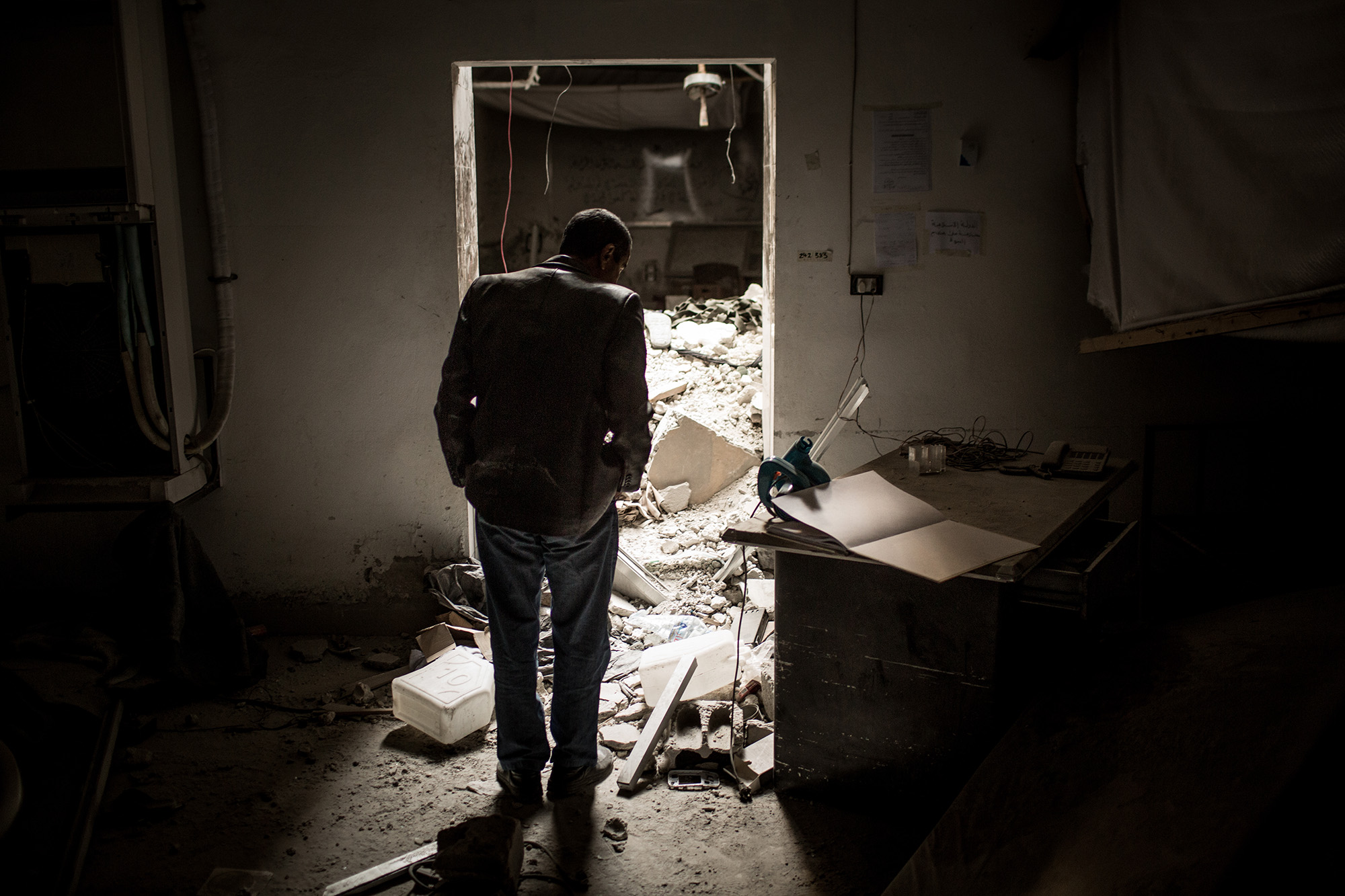
The international fighters bristle when I point out that the supposedly anti-authoritarian PYD seems to control everything in Rojava. Its constitution guarantees freedom of the press and the freedom to organize, but Berzan Liyanî, a Kurdish journalist I’d met, was imprisoned for six months in 2017 on charges of practicing journalism without a license and being part of an unapproved TV channel. He was held in solitary confinement for 45 days in a five-by-seven-foot cell in a “counterterrorism” prison. Later, he was put in a cell with ISIS fighters. His interrogators accused his network of inciting opposition to the local security forces and the self-administration.
After I recount this story, Bastien asks whether Liyanî was affiliated with the Kurdistan Democratic Party of Syria (KDPS). He was, I say.
“Well, what do you expect? I think they should be illegal here.”
“Why?”
“They are like an agent of a foreign government.” The KDPS is the Syrian affiliate of a conservative-leaning nationalist party led by Masoud Barzani, the former president of Iraqi Kurdistan. I point out that the YPG is backed by the United States. He says that’s not the same thing: “The YPG wasn’t created by the US. Maybe this guy was a spy. Maybe he was working for Barzani. Maybe he was not only a journalist. Maybe PYD has intelligence.”
“He wasn’t charged with spying.”
“If he is a member of the [KDPS], he is an enemy.”
Other members of rival Kurdish parties also have been imprisoned in Rojava. In Turkey I met Tami, the Kurdish Future Movement member, who is now a refugee. He told me that in 2017, on a visit to Rojava, he was thrown into a secret prison where masked men badgered him about his party’s opposition to the PYD. His cell was so packed that prisoners lost consciousness because of the lack of oxygen. The interrogators told him they had secret prisons all over Rojava. (When I ask the Asayish if I can see a prison, I’m told all the prisons are under repair and aren’t ready to visit.)
I tell the international fighters about the Black Prison in Afrin, a once-notorious destination for FSA fighters and for Kurds opposed to the PYD. After the Turkish invasion in early 2018, Syrian journalist Khalifa Kuder recorded video inside the prison, showing pitch-black solitary cells barely large enough to lie down in. One was a hole in the ground. Former inmates testified they were fed bread and water and forced to read Öcalan.
“Certain people who do certain actions void certain rights,” Barry says. “I wholly think they deserve it. I have absolutely no sympathies for them.”
“I don’t believe this story,” Bastien interjects. “I think it’s fake news. As a policy, there is absolutely no political repression. That’s Turkish propaganda. Turkish bullshit.” He eyes his comrades. “We should ask the critical left in the US or in Europe: Overthrow your government, create a militia, fight back ISIS, fight back the Turkish state, fight back the Assad regime. Try to implement a democratic system surrounded by enemies in a war situation.” He looks directly at me. “Do this, and then we’ll consider your criticism. The criticism of the left when you are sitting back in the US, looking at this from very far—I don’t really give a shit about this, to be clear.”
“The moral high ground that people take from a comfortable stance in a place that’s far away with no real idea of what’s going on,” Barry says scornfully.
“But a lot of these people are Syrian,” I say.
“We should go,” Bastien says. He gets up, and the others follow.
In the plains near the Iraq border, I pull up to a refugee camp surrounded by a chain-link fence. For the first time since I’ve been in Syria, I see women with covered faces and flowing black abayas. Children scamper between rows of tents covered with white plastic tarps. The Kurdish official who arranged for me to come here said the YPJ was holding hundreds of women who had come from dozens of countries to join ISIS. Most of their husbands are dead, in prison, or still fighting to hold the last scraps of ISIS territory. Many of their governments have refused to take them and their children back. Several Kurdish officials I’ve interviewed have brought up this problem. They say they don’t have the resources to hold all these people indefinitely.
I am met by a Kurdish British YPJ intelligence officer with a thick London accent who is annoyed that I showed up and annoyed with Americans generally. “How it is that when it came to ISIS we was friends but when it came to Turkey in Afrin, we wasn’t friends?” she asks. “I’ve said this to the CIA. I’ve said this to the FBI. If Turkey attacks here, what are you going to do? Just leave here and go?”
I ask if I can walk around the camp. She says no. Can I take pictures? No. Are there any American women here I can interview? They don’t want to talk to journalists. Okay, I tell her. I’ll talk to anyone. She walks away.
I stand around staring off into the sky, trying to make out the languages the women are speaking around me. I hear German, French, Egyptian Arabic. A white woman approaches me. Her long brown hair is spilling out of a beanie, and there is a black tattoo of a kiss on her neck. She tells me she’d like to talk. She’s from Indiana. She says she’s Christian and that she’d come here with her young son and daughter after her husband decided to join ISIS without telling her. “I was not aware that we were coming to Syria,” she insists. For three years, she lived in Raqqa, under ISIS control, and had two more children. She just got out and is trying to convince the US government to send her and her kids home. Her name is Samantha Elhassani.

